
22.03.2008

http://ejmas.com/jalt/jaltart_Coetzee_0902.htm
InYo: Journal of
Alternative Perspectives Sept 2002
By Marié-Heleen Coetzee
Copyright © Marié-Heleen Coetzee 2002. All rights reserved.
1a. Introduction
The Zulus are one of the Nguni people of South Africa. Linguistically and culturally, the Xhosa, Pondo, and Thembu are Southern Nguni, while the Zulu, Swazi, and Ndebele are Northern Nguni.
During the 1810s, a Zulu leader named Shaka kaSenzangakona established an empire in northeastern South Africa whose military relied on phalanxes rather than skirmish lines. His armies were highly successful, and within a few decades, his style of warfare spread as far north as Lake Tanganyika.
Although Shaka was assassinated in 1828, his kingdom survived until 1879, when it was destroyed by the British, who feared a Zulu attack on the white settlements then expanding outward from Durban. The Zulu culture, however, survived into the present, and today there are about 8.8 million Zulus, most of whom still live in KwaZulu-Natal. (The name Natal is owed to the Portuguese explorer, Vasco da Gama, who reached its coast on Christmas Day, 1497.)
The genealogy of the presumed originators of Zulu stick fighting is traced to Amalandela, son of Gumede, who inhabited the Umhlatuze valley about 1670 (Werner, 1995:28). The exact location of Amalandela’s former habitat remains an enigma.
According to Bryant (1949:3), Amalandela was a member of the Ntunga Nguni clan. According to Dalrymple (1983:74), he fathered two sons, respectively named Qwabe and Zulu, and the latter gave his name to the Zulu people.
The recent history of stick fighting is traced to the legacy of the Zulu king Shaka. Shaka lived from 1787 to 1828, and during his reign, he established the Zulu Empire and became Southern Africa’s most legendary warrior-king.
Until recently, historians credited Shaka with the development of Zulu warfare, with its emphasis on stabbing spears and phalanxes, but recent research suggests that the weapons, strategies, and tactics accredited to him were established before his rise to power. The great warriors preceding Shaka, like so many historical figures and events, are hidden from documented history, and forgotten even in the oral traditions.
Nonetheless, it is generally agreed that during Shaka’s reign, stick fighting was used as a means of training young men for both self-defence and war. Shaka himself, in Ritter’s version of the story, was already a highly proficient stick fighter at the age of 11 (1957:14).
2a. Introduction
Zulu stick fighting provides an opportunity for men to build courage and skill, to distinguish themselves as proficient warriors, and to earn respect in the community (Ntuli, Interview, 1996). Leitch (Interview, 1996) is of the opinion that the techniques and manoeuvres applied in stick fighting are identical to those implemented during traditional Zulu warfare, the only difference being the weapons used. Nonetheless, stick fighting is a game, and the dynamics of stick fighting are generally playful. The exceptions are when sticks are used for self-defense or in a faction fight, or when amashinga (professional stick fighters) compete.
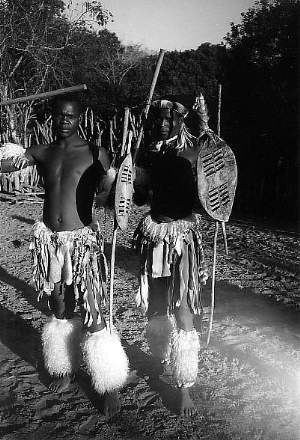
2b. Nineteenth Century
According to Ntuli (Interview, 1996), Shaka (reigned 1816-1828) rewarded good and courageous stick fighters with cattle, terming the practice ukuxoshisa. Ntuli further postulates that the relationship of stick fighting to military practice was still prevalent during the time of Shaka’s successor Dingane, who ruled until 1840 (e.g., into the era of early white settler encroachments into the interior of KwaZulu-Natal). Ndlela kaSompisi, commander-in-chief of Dingane’s army and senior induna (prime minister) to Dingane, was arguably the most important figure in Zululand after the king (Becker, 1964:69). Certainly Ndlela’s experience and skill in stick fighting assisted him in climbing the military ladder, and helped him earn a distinguished reputation. Ntuli (Interview, 1996) is a direct descendant of Ndlela.
During the lifetime of the next major Zulu king, Cetshwayo (1836-1884), stick fighting was an accepted means of resolving the internal disputes (Laband, 1995:178). During this era, combatants used the shafts of spears in a stick fight, but not the blades (Laband, 1995:178). Additionally, stick fighters were to follow a code of conduct, as stick fighting, unlike warfare, was not intended to cause loss of life.
Laband (1995:178-179) describes an unusual event in which the protocol of stick fighting was breached. The occasion was a stick fight between two of Cetshwayo’s regiments (amabutho). This fight took place on December 25, 1877, during the UmKhosi, or advent of the first fruits, festival. It seems that Cetshwayo crammed his favourite iNgobamakhosi regiment (ibutho), consisting of young, unmarried men, into the same quarters as the uThulwana ibutho, which was made up of older, married men. Cetshwayo and some of his brothers belonged to the older ibutho. The younger men apparently did not respect the customary power relations between themselves and their elders, and were dissatisfied with arrangements concerning the reception of wives of the uThulwana. The rising levels of antagonism between the two parties eventually led to a physical clash. The older uThulwana ibutho intentionally disregarded an accepted convention by attacking the iNgobamakhosi with spears after an initial defeat by the iNgobamakhosi. For their malpractice, Cetshwayo prohibited the uThulwana from further participation in the festivities, and in addition,the men were fined "a beast all round" and sent home.
Although the British effectively ended Zulu military power in 1879, stick fighting apparently continued to play a political role throughout the lifetime of the Zulu king Dinuzulu (1868-1913). Ntuli believes that in Dinuzulu’s times, a skilled stick fighter was appointed to train the heir to the throne in the art of stick fighting (Interview, 1996). Thus, the king’s leadership abilities and his potential as a military commander were judged according to his (presumably superior) martial prowess.
In Shaka’s time, stick fighting was used as training for warfare. However, during subsequent years, Zulus began using stick fighting to represent conflict resolution on a symbolic rather than military level. This form of symbolism still appears in the inter-district umgangela, or stick fighting competitions, held in rural areas such as Nongoma. Still later, stick fighting came to function as an expression of Zulu ethnicity, and to show political affiliation with the Zulu-dominated Inkatha Freedom Party (Mnqayi, Personal Communication, 1998).
Leitch (Interview, 1996) argues that this decontextualisation and exploitation of stick fighting for political gain has negatively affected perceptions of the art. For example, crowds misuse elements of stick fighting during marches in cities, or use their fighting sticks to express ethnicity. This association of stick fighting with violence and riots negates its profundity and beneficial social implications, and accordingly, many Zulu people distance themselves from the art (Mnqayi, Personal Communication, 1998).
Leitch (Interview, 1996) also believes that instances where crowds run out of control parody the traditional function of stick fighting in society. Control, respect, and accountability lack in such marches, whereas they are of the utmost importance in a stick fight. Qoma (as cited by Krog, 1994:42) states that the use of sticks became politicised to the extent that any African person carrying a stick is classified a "violent Zulu". As such, a practice that once played an instrumental role in building the pride of a nation has come to be regarded with contempt by some (Ntuli, Interview, 1996).
In the Tugela Basin and the South Coast (different areas than where I did my research), stick fighting has all but disappeared. Stick fighting is practised less frequently than in the past in KwaDlangezwa and Ongoye, too, apparently due to its association with recent violence (Mnqayi, Personal Communication, 1998). Leitch (Interview, 1996) believes that traditional stick fighting is nowadays only found in areas where there is little political friction.
Nonetheless, traditional stick fighting still takes place in some of rural areas of KwaZulu-Natal, where it continues to act as a process of socialisation, and to transmit the social norms of the community in which it operates. Therefore, while the practice of stick fighting is constantly modified by changes in the social system, it can still serve as a vehicle for mastering the body and mind, and be instrumental in nurturing the practitioner’s dignity and pride as a man (Ndaba, Interview, 1996).
In the immigrant communities of Johannesburg, migrant Zulu workers sometimes teach stick fighting as a martial art. Meanings derived from these interactions are primarily related to sportsmanship (Qoma in Krog, 1994:42), and lack the integral social affiliations of traditional stick fighting. Stick fight demonstrations offered to tourists, such as at Shakaland (Home-video recording, 1996), are performances.
Long past its days of glory, stick fighting is no longer a common practice among the Zulu people, and practitioners struggle to validate its existence in these days of political turmoil, acculturation, and modernisation. Nonetheless, stick fighting appears to assist in upholding the traditional social system by perpetuating socially accepted modes of male behaviour and ideals. Stick fighting, as a cultural tradition, therefore continues to fulfil its traditional didactic function in some Zulu communities.
3a. Introduction
Zulu men traditionally owned fighting sticks (izinduku). The sticks were stored in the roof of a house, and were carried for self-defence or used when the owner was challenged to a stick fight (Ntuli, Interview, 1996).
Adult males often owned several fighting sticks, and from these, they selected a pair to fight with (Ndlangavu as cited by Krog, 1994:42).
At the age of about 16, a Zulu boy’s father took him into the forest to choose and cut his own fighting sticks from trees. (Fighting Sticks, Episode 2, [S.a.]). As an adult, a man might make his own izinduku or employ a specialist to do so. Apartheid laws prohibiting South African people of colour from owning guns or displaying traditional weapons in public led to the use of instruments such as umbrellas and ordinary walking sticks as substitutes for traditional izinduku (Fighting Sticks, Episode 1, [S.a.]). Nonetheless, the practice of carrying sticks still prevails in some rural areas of KwaZulu-Natal, such as KwaDlangezwa.
Izinduku may differ in appearance according to their region of manufacture (Mzobe, Interview, 1996). However, regardless of appearance, izinduku must be stout enough to withstand the impact of blows from an opponent’s weapons.
Although the choice of wood for fighting sticks is often specific to the practitioner’s family lineage, (Fighting Sticks, Episode 2, [S.a.]), various local trees are suitably strong for use as fighting sticks. Thus, izinduku are made from trees such as the umqambathi, umazwenda, ibelendlovu, umphahla (Ntuli, Interview, 1996), umthathe, and umunquma (Ndlangavu as cited by Krog, 1994:24). [EN1]
Decorations on izinduku are for aesthetic purposes or to identify members of the different sides in a regional stick fight (Zulu, Interview, 1996). Decorations on the fighting sticks of informants observed at Nongoma include painted patterns, beadwork, and pieces of cloth.
For faction fighting and war, there are a number of sticks available. Examples include the short stabbing spear or iklwa, the swallow-tail axe or isisila senkonjane, the isizenze axe used by commoners, and the long spear named isijula (Derwent et al., 1998:86). The knobkerrie, or iwisa and isagila, is also available. Stick fighters, however, make use of two specific sticks in single combat.
The first stick is the offensive fighting stick, or induku. [EN2] This is a strong stick or shaft of wood without a knob carved smooth and used specifically for stick fighting.
The length of the induku depends on the physical stature of its owner, but is generally about 88 centimetres in length. The induku’s circumference increases slightly from bottom to top, and the extra weight that the head carries enhances the mobility of the stick during offensive manoeuvres.
The induku is held in the right hand, and used to strike at the opponent’s body and head. [EN3] A piece of cowhide can be tied around one end of the stick to secure the fighter’s grip on the weapon, and the whisk of a cow’s tail can be tied around the bottom of the stick to hide a sharp point. Although this sharp point can be used for stabbing, doing so is not considered appropriate during an honourable stick fight.

3d. Blocking Stick (Ubhoko)
Ubhoko or blocking stick, is a long, smooth stick that tapers down to a sharp point. As a defensive weapon, it is skilfully manoeuvred with the wrist of the left hand, and used to protect the body of a combatant from the opponent’s blows. Although its length depends on the physical stature of its owner, the ubhoko is meant to ensure protection from head to foot, and so is notably longer than induku. Ubhoko is generally about 165 centimetres in length. Like induku,ubhoko’s circumference increases from the grip upwards.
Although the ubhoko could be used as a stabbing weapon, in a stick fight, protocol demands that it be used exclusively for the purpose of defence. The action of defence with ubhoko can be referred to as ukuvika or ukuzihlaba (Mzimela, 1990:12).
Another short stick, umsila, is held in the left hand together with ubhoko. Not used for fighting as such, it is used instead to uphold the small shield, or ihawu, that protects the left hand. (The umsila runs vertically down the middle of the shield through four triangular nooses, and tapers to a point.) Fighters in Nongoma maintain that umsila is also used to protect the face during a stick fight. As an aesthetic accessory, Nongoma fighters tie strings of antelope skin to the top of umsila.
Ihawu is a relatively small and oval shaped piece of cow skin, held in the left hand. During Shaka’s regime, warriors were ranked by means of the colour of the shields they carried (Fighting Sticks, Episode 1 [S.a.]), but this convention is seemingly not evident in the choice of shields used for stick fighting.
There is no set size for ihawu, although it should be large enough to protect the hand and wrist, and small enough not to impede on ubhoko’s mobility. As a rule, however, the shield used for stick fighting is between 55 centimetres and 63 centimetres long, and 31 to 33 centimetres wide. A handle big enough to hold two or three fingers (the index, middle, and ring fingers) is located at the back of the shield, left of the umsila. Fighters first clutch the handle with two or three fingers before placing ubhoko in the left hand.
A soft cushion is placed on the inside of the shield to ensure that the hand remains protected from an opponent’s blows. Traditionally, this cushion was made from sheepskin, and called igusha. In contemporary times, sponge or other soft material, named isibhusha, has been utilised as a protective measure inside the ihawu (Zulu, Interview, 1996).
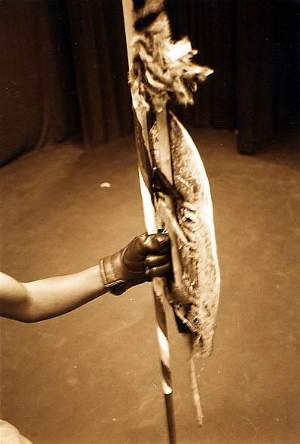
4. Traditional Medicine (Intelezi)
4a. Introduction
Traditionally, Zulu stick fighters prepared for a fight using medicine (intelezi) prepared by a herbalist (inyanga). In contemporary times, the widespread use of intelezi has been inhibited by changes in the social and religious structure of Zulu communities (Zulu, 1996). This is probably due to European and missionary influences.
Krige (1965:329) identifies intelezi as "the generic name for all medicinal charms, the object of which is to counteract evil by rendering its causes innocuous". Intelezi is also a collective name for a variety of sprinkling charms. The kind of traditional medicines used on sticks vary according to specific purposes, and specific ingredients are necessary for the outcome required (Stewart, Interview, 1996). Specific intelezi used for stick fighting assist in warding off evil, going into battle at a psychological and physical advantage, weakening the opponent, and strengthening sticks.
Before battle, Zulu armies underwent cleansing rituals conducted by inyanga (herbalists) and/or isangoma (diviners). A very important aspect of this preparation involved the sprinkling of the warriors and their weapons with a certain intelezi the day before the battle (Stewart, Interview, 1996). Krige (1965:272) points out that the process of sprinkling, called chela in Zulu, could also take place just before a battle commenced. Krige (1965:272) provides a detailed description of the ritual procedures related to the cleansing and strengthening of warriors.
Intelezi is not used exclusively for battles. For example, stick fighters often use intelezi to strengthen their sticks before accepting a challenge. Reportedly this increased the strength of the sticks in order to withstand attacks, and multiplied the impact of the offensive blows (Ntuli, Interview, 1996). Other intelezi can reportedly cause dizziness, strokes, or impair the vision of an opponent (Mzobe, Interview, 1996). My personal sample of intelezi prepared by an inyanga in KwaDlangezwa in December 1998 contained a silvery ingredient said to cause bright flashes to appear before the opponent’s eyes, thus distracting him and negating his concentration.
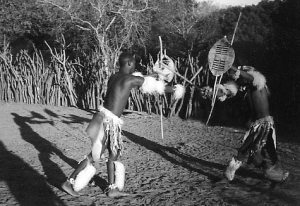
4d. Rituals Associated with Stick Fighting
The intelezi rituals used before a stick fight bear a striking resemblance to the rituals associated with traditional Zulu preparations for warfare. For example, on the day preceding an umshado or wedding ceremony, sticks are treated with intelezi and left overnight outside the home (Mbanjwa, Interview, 1996), usually at one end of the cattle enclosure (Stewart, Interview, 1996). When two unrelated groups of men prepare for a clash, the ritual proceedings take place at the home of an induna (local leader). Again, the sticks are kept in the intelezi until the next morning (Ntuli, Interview, 1996).
The sample of intelezi obtained by Mnqayi is a brown powder. Details regarding the application of intelezi are subject to notable differences in opinion, but informants generally agree that the intelezi is mixed with water and placed in an ordinary clay pot (Stewart, Interview, 1996). On the morning of the fight, the stick fighters go to the cattle enclosure, where they make use of the intelezi (Mbanjwa, Interview, 1996).
Vusi Buthelezi (Interview, 1996), the inyanga yemithi at Dumazulu, explained that the intelezi is sprinkled on the weapons in the cattle enclosure in acknowledgement of the congregation of ancestors inhabiting the territory. Alternatively, the izinduku are placed in the intelezi, which is washed onto the weapons with a broom (Mbanjwa, Interview, 1996) or dipped into the medicine (Ntuli, Interview, 1996). Some fighters also drink the intelezi.
In a powder form, intelezi may be administered through small incisions in the skin called ingcabo. This manner of applying intelezi forms part of the fighter’s preparation for the contest. Buthelezi (Interview, 1996) states that ingcabo are made on:
Small quantities of intelezi in powder form are taken orally in small quantities, usually after mixing it with sugar and then eating the mixture from the palm of the hand. This method reportedly provides the stick fighter with psychological and physical strength.
During the fight itself, intelezi are put inside a leather band that is tied around the biceps for the duration of the fight (Fighting Sticks, Episode 2, [S.a.]). Finally, some stick fighters place the bark of the uphindamshaye climber under their tongues, chew on it, and then spit it onto the opponent during a fight (Mzobe, Interview, 1996).
Like fighters, sticks are routinely treated with ritual medicines. For example, the use of menstrual blood or snake venom is considered a dangerously potent stratagem.
Historically, menstruating Zulu women were considered unclean, and a number of social taboos had to be respected during the menstruation period (Krige, 1965:82). The Zulu people believed that a woman lingers in a marginal state of existence during menstruation; she does not completely surface in life or death, but abides in a state of transition (Clegg, Personal Communication, 1996). In intelezi relating to stick fighting, menstrual fluids are combined with a number of other medicinal substances, and then applied to the sticks. This allegedly renders the opponent’s defence impotent (Zulu, Interview, 1996). The use of menstrual blood on sticks is known among stick fighters at Nongoma. However, according to Clegg (Personal Communication, 1996), this practice is more prominent in the province that was known as Natal prior to the 1994 elections than in the province that was known as KwaZulu before the elections.
Mzobe (Interview, 1996) explains that snake venom, especially that of the mamba and the cobra, can be utilised as protective medicine for sticks. Medicine relating to the use of snake venom is termed isibiba (Zulu, Interview, 1996). To paraphrase Mzobe’s statements, a snake is barbecued and its body ground up, then mixed with fat and smeared onto the fighting sticks.
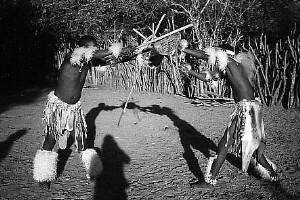
4f. Associated Medicinal Plants
To keep opponents from working counter-spells, the exact nature of the medicinal plants used for intelezi is secret.
Nonetheless, some generalisations are possible. For example, the ingredients generally consist of a number of herbs and plant extracts, and an inyanga can obtain ingredients for the medicine from as far afield as Zanzibar (Mzobe, Interview, 1996). To give a second example, one kind of intelezi consists of the climber uphindamshaye and the uphind’umuva cut into pieces, then mixed together with a small aloe named cene and the roots of the uMazwende tree (Buthelezi, Interview, 1996). [EN4]
Intelezi can be bought from an inyanga. In the past, herbalists were offered cattle for the service of preparing the medicine to strengthen the sticks of the combatants. Nowadays money is acceptable as payment for the inyanga’s assistance (Ntuli, Interview, 1996). Intelezi can still be bought in rural areas of KwaZulu-Natal or informal trading areas such as taxi ranks. The prices in KwaDlangezwa in 1998 ranged from R400 to R2 000 (about US $40-$200) depending on the availability and geographical location of medicinal plants, and the sort of plant or animal extracts used (Mnqayi, Personal Communication 1998). An inyanga can specialise in the field of fighting intelezi, and be consulted exclusively for such purposes. It is not necessary for the inyanga to apply the intelezi personally to the sticks or fighter, only to prepare it.
Intelezi, or medicine, is intimately associated with traditional Zulu stick fighting. However, as stated earlier, it seems as if the widespread use of intelezi has been inhibited by changes in the social and religious structure of Zulu communities, possibly due to increased urbanisation and Westernisation.
5a. Introduction
Tyrell and Jurgens (1963:111) point out that Zulu children did not receive much formal education designed to mould them for their roles in traditional society. "Traditional education for the individual constitutes a gradual absorption into society and the acquisition of certain skills and behaviour patterns". In this world, informal stick fighting was one of the "skills and behaviour patterns" that instructed Zulu males about the social roles, qualities, and behavioural patterns expected of them. Younger boys fought with sticks while tending herds, while older boys and young men sparred publicly at ceremonies and festivals (Mzobe, Interview, 1996). The practice of sparring with sticks is called ukungcweka, and it differs from a stick fight challenge (Msimang, 1975:166).
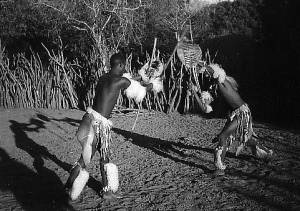
5b. Learning to Spar
From an early age, a Zulu boy was expected to look after cattle in the field, "exploring his manliness and independence in a world away from parental supervision". Part of this exploration involved a boy’s fighting his way up to a position of leadership among the other herders (Tyrell and Jurgens, 1983:11, 115). The way he did this was by defeating his age mates at sparring with sticks.
The intricate skills of stick fighting and sparring are learned by observation, imitation, and experience (Stewart, 1996). Very young boys train using switches or small sticks, and they practice their skill with the sticks on trees in preparation for fighting another boy. Fathers also instruct their little boys in the art by standing on their knees and sparring with the child (Stewart, Interview, 1996).
Sparring can be a daily occurrence amongst the herd boys. No specific amount of time is set aside for training; it occurs when the situation arises. Nonetheless, boys use every opportunity to spar and thereby establish their reputations as stick fighters and thereby prove their manliness.
To incite a sparring match, Ndaba (Interview, 1996) states that herd boys often engage in "verbal gymnastics". The competition and sparring does not have to take place according to age groups; older boys can clash arms with younger boys. Although this could lead to physical bullying, no one is compelled to take part in a game of sparring. According to Krige (1965:79), the recognised manner of challenging another herd boy to a sparring match is to tap him on the head with a stick and utter a daring verbal comment. Comments such as "I am your master" (iNgqotho) are considered invitations to a fight. The challenged then either prepares to fight or agrees with the statement and prevents a fight.
Sparring between herders takes place under strict supervision of the inqwele, or leader of the herd boys (Ntuli, Interview, 1996). The inqwele assumes his position of leadership after defeating all the opposition in the area during stick fights. Refinement of stick fighting skills is encouraged, as the other herders judge the proficiency of the combatants. An informal audience is thus present during the training process.
There are strict rules governing the sparring exercise. Partners sparring with the sticks do not aim to hit each other’s heads, and often do not use an ihawu (small shield). As such, a hit to the hand is a foul. Should any of the participants fall down or lose their stick, the sparring stops until sparring partners are on equal footing again. It is not necessary to use induku or ubhoko, and rough branches of trees are accepted substitutes for fighting sticks (Msimang, 1975:166). Exclamations indicating an acknowledgement of a hit (ngiyavuma) or requests to stop the sparring (khumu or malushu) are utilised for both sparring and combat, and are strictly adhered to.
No matter how important the role of sparring with sticks in the social construction of masculinity, it is an undesirable skill for females. Should a woman "jump over the sticks", especially during her menstrual cycle, misfortune is supposed to fall upon the owner of the sticks (Ntuli, Interview, 1996). Ironically, menstrual blood can be a potent medicine for strengthening the sticks when applied in conjunction with a number of other substances (Zulu, Interview, 1996). Nonetheless, Leitch (Fighting Sticks, Episode 1, [S.a.]) indicates that Zulu women can and will use this martial art when necessary. If a man has no sons to tend to the cattle, one of his daughters has to go to the field with the herd boys and she learns to stick fight with them. Tankiso Mafisa (Personal Communication, 1996) stated that her mother used to tend to cattle as a young girl, and stick fight with the boys.
6a. Playing Sticks (Ukudlalisa Induku)
Competitive stick fighting at festivals is called ukudlalisa induku, or "play sticks" (or alternatively, ukudlala induku, which roughly translates as "play sticks with you"). Although Msimang (1975:166) argues that by teaching methods, techniques, manoeuvres, and rules, sparring prepares the boys for fighting in single combat, Zulu stick fighting is essentially playful in nature.
Schoeman (1975:166) says that playing sticks at festivals such as the iphapu (lung festival) provide an opportunity for Zulu boys and men to experience first-hand different strategies, techniques, and rules. Derwent et al. (1998:36) argue that a challenge to play sticks can only take place at a wedding, but other sources contest this viewpoint. For example, stick fights challenges have been reported at the first fruits festivals (Clegg, 1981:8), the installation of a new traditional leader (Larlham, 1985:13), and inter-district fighting (Clegg, 1981:8). Stick fighting also occurs at social gatherings such as beer drinking (Stewart, Interview, 1996), an imbizo (Zulu, Interview, 1996), the iphapu festival (Schoeman, 1982:49), courtship (Stewart, Interview, 1996), and the thomba ceremony (Elliot, 1978:143). These sources do not indicate the nature of the combat, e.g., whether it was ukungcweka or a challenge.
Stick fighters begin to fight competitively at public ceremonies and social gatherings at about 18 years of age (Ntuli, Interview, 1996). The youngest fighters are about 15 years old, but it is unusual for a boy to start fighting publicly before he has fully passed puberty. When a boy reaches puberty, he receives a second name that is indicative of a contribution he made to the community (Stewart, Interview, 1996). This second name, or isithopo, may be self-composed or granted by peers and parents. Either way, the second name gradually develops into a personal izibongo that mediates an individual’s personal and social identity (Brown, 1998:87). This is mentioned because during a stick fight, the fighter is called by his second name, and his friends recite the story of how he acquired this second name (Stewart, Interview, 1996; Mzobe, Interview, 1996). Dumisani Mbhense (Personal Communication, 1996) points out that the recital of praises by the fighter’s peers is an enjoyable aspect of the action. Consequently, izibongo are statements of friendship among a combatant and his friends/family.
Leitch (Interview, 1996) points out that stick fighting is considered an activity for the young. Thus, a man will usually stop fighting in his mid-thirties, by which time he has earned respect as a proficient stick fighter. Older men assume responsibility for upholding the fabric of society, and become mentors to the younger men. Furthermore, to "retire" from stick fighting while your reputation as a fighter is intact is a means of ensuring that you remain respected as a warrior in your older days.
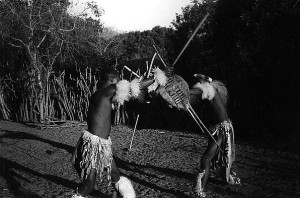
6b. Surrogate and Professional Stick Fighters
Although Zulu people consider it chivalrous to fight one’s own fight, it is acceptable to stick fight on behalf of another person. Such a person might be an aggrieved younger brother who lacks experience in the skill, or someone who is unable to fight at the time. For example, a migrant labourer can request a man back at home to fight on his behalf. As such, he does not have to leave his work to stick fight and settle the issue at hand (Fighting sticks, Episode 1, [S.a.]).
Stick fighting can also take place on a "professional level". Leitch explains that a professional stick fighter, or ishinga, travels around in search of stick fights (Interview, 1996). According to Mzobe (Interview, 1996), the term ishinga refers to a very brave and even rude person. Unlike "social fighters", to use Leitch’s (Interview, 1996) phrasing, an ishinga’s only ambition is to demolish the opposition and earn another victory as the top stick fighter. His only reward is social recognition. He normally uses well-worn fighting equipment, and has an unkempt appearance. Men tend not to fight him, since the element of play is seemingly lacking in the ishinga’s approach to stick fighting. Mzobe (Interview, 1996) states that in cities such as Johannesburg, amashinga can fight for prizes or money. However, social stick fighting normally does not have an economic reward for the participants involved.
7a. Introduction
Stick fighting takes place at different times, occasions, and places. As information about technical aspects of Zulu stick fighting appears in The Fight Master, 34: (2), 2001, it will not be repeated here. However, the rules and protocols of stick fighting deserve some attention.
For the most part, stick fighting takes place outside the cattle enclosure of a homestead (Ntuli, Interview, 1996). If a stick fight does take place inside the cattle enclosure, it is a fight among the men of that family, or umuzi. (Other people would not fight inside another’s cattle enclosure, due to the presence of a family’s ancestors in the enclosure.) However, should a stick fight be connected to the chief, then the fight might take place in his cattle enclosure (Stewart, Interview, 1996).
Other than this, there is no space specifically set aside specifically for stick fighting. Instead, a space is selected to suit the needs of the occasion (Leitch, Interview, 1996). In urban areas such as Johannesburg, stick fights take place on Friday or Saturday evenings in the hostels (Ndlangavu as cited by Krog, 1994:42).
The action and structure of a stick fight follow a common, recognisable pattern. The reason is that for Zulus, stick fighting is a gentleman’s game, and specific rules and protocol govern its practice. Breach of rules or protocol is unacceptable, as it indicates that the fighter does not have confidence in his own abilities to beat the opponent by the rules (Ntuli, Interview, 1996). A man only proves his supremacy at stick fighting in a fair fight, or "impi yamanqanu", where the rules are followed (Derwent, et al., 1998: 83).
Derwent et al. (1998:63) state that a stick fighter voices a challenge to indicate that he is ready for fighting. Elders should grant permission for a fight before any challenge is made. Mbhense (Personal Communication, 1996) calls a challenge "inselelo". At public ceremonies the warrior captain, or umphathi wezinsizwa, is supposed to regulate the activities, but induna sometimes fulfil this function (Mbanjwa, Interview, 1996).
The person regulating the fight should make sure that the correct sticks are utilised, that "the weight is the same, that there is no possibility of your adversary being unduly hurt" (Ndaba, Interview, 1996). His task is thus to ensure that the rules are followed, and that a fair fight takes place. Warrior captains can remain in command up to their late forties, and would only engage in a stick fight when forced to assert their authority (Leitch, Interview, 1996). A man fights his peers, and not someone significantly younger or older that himself.
Once people have gathered around the selected space, the stick fighters take turns demonstrating ukugiya (solo display of stick fighting skills) against imaginary opponents. Ukugiya derives from fighting in single combat, and is where each individual can display his own characteristic style (Dalrymple, 1983:160). Historically, ukugiya prepared fighters psychologically for warfare and reaffirmed the army’s superior skills, and today ukugiya still takes place before a stick fight (Leitch, Interview, 1996).
Ukugiya do not follow set floor- or step patterns (Dalrymple, 1983:160), and are usually accompanied with praises, called izibongo, and war cries and chants, called izigiyo (Gunner & Gwala, 1994:1). Izigiyo are characterised by a militaristic phallocentrism, and often liken men to powerful totems such as bulls or lions that are self-reliant and "fiercely individualistic" (Derwent et al., 1998:70,136).Gunner and Gwala (1994:230) cite an example:
Gunner and Gwala (1994:231) translated this war chant into English:
Leader: The bull came again!Credo Mutwa (1992:12) also uses a Zulu izigiyo in his play uNosilimela:
Ikhalaphi?Gunner and Gwala (1994:230) document this chant, too, although their documentation differs slightly from Mutwa’s in terms of spelling and punctuation. Gunner and Gwala’s last line also differs from Mutwa’s, reading "Ukuthi Ikhalaphi". Anyway, their English translation (1994: 231) of this izigiyo reads:
Where does it call from?Izibongo occupy a distinctive cultural space, and served a political function within the stratified Zulu monarchy (Brown, 1998:50). Izibongo in the ukugiya before a stick fight is understood in relation to izibongo recited at other occasions, but remains distinctly different from those. For detailed accounts of the various izibongo and discussion of their social significance, compare Gunner and Gwala (1994) and Brown (1998).
Izibongo in the ukugiya often link the fighter with a powerful animal. For example, Shaka’s izibongo often referred to him as lion or elephant (Brown, 1998:98). Izibongo can also associate a fighter with the heroic deeds of his ancestors (Leitch, Interview, 1996). These observations echo in the izibongo of Siyabonga Mzobe, recited by himself as an example of the manner in which his friends praise and encourage him during a stick fight:
Mzobe translated the praise as:
Small horns,The ukugiya is therefore a statement of the fighter’s own ethos; a statement of himself as warrior, a celebration of youthful masculinity, and a display of physical prowess that can include re-enactment of heroic battles of the past. The praise is not necessarily serious, but can include comic elements such as jokes and humorous physical actions intended to amuse onlookers (Leitch, Interview, 1996).
Although Gunner and Gwala (1994:1) point out that izigiyo and ukugiya are closely associated with "war and martial prowess", they add that in contemporary South African life, "they stress a potential rather than constant all-embracing link with war and the martial". Thus, the ukugiya is not performed exclusively as an introduction to physical conflict. Instead, it has transcended its historical roots to become a celebration of youthful masculinity:
The ukugiya is still performed before faction fights (Ntuli, Interview, 1996) and stick fights (Clegg, 1981:10). Its continued use in stick fights is perhaps in recognition of stick fighting as a form of symbolic warfare.
Following the performance of a ukugiya, the challenge takes place. Mbhense (Personal Communication, 1996) calls a challenge inselelo, or "I challenge you to fight".
The challenge is unambiguous and clearly distinguishable from the action. The challenge often involves the challenger slowly circling the fighting space while brandishing his shield, then bounding across the space up to the chosen opponent and shouting Nansi Inkunzi, or "here is the bull" (Derwent et al., 1998:63).
To accept the challenge, a man from the opposite party steps forward, and replies, "And here’s another bull" or nansen yinkunzi! Another reply to inselelo is woz’uzithane izinduku or "sticks understood" (Alegi, 1997).
Fighters do not rush into an attack after the challenge is accepted. Instead they square up and exchange blows to the shields, thus giving each other a chance to warm up to the situation. Stewart (Interview, 1996) believes that the warm-up also gives the fighters a chance to detect a weakness in their opponents’ defence.

The intensity of the action increases after the initial prodding, causing the fight to escalate (Fighting Sticks, Episode 1, [S.a.]). During this portion of the fight, the men consciously focus on the weak points of the opposition.
One of the basic rules of a stick fight is that stabbing is not allowed. (Zulu, Interview, 1996). In addition, a club or a stick with a knob is not used in a challenge match (Ntuli, Interview, 1996). Furthermore, if a fighter drops his stick, it is honourable to give him a chance to pick it up before resuming the fight (Fighting Sticks, Episode 1, [S.a.]). The main aim is to strike the opponent’s head (the action is termed ukuweqisa). Thus, all the blows delivered to the body attempt to create an opening in the opponent’s defence, in turn allowing the stick fighter to strike his opponent’s head.
Foul play includes hitting a man with your shield and tripping him (Zulu, Interview, 1996). If a man falls down, he should not be hit, but rather receive a chance to regain his composure before the fight continues (Fighting Sticks, Episode 1, [S.a.]). Frustration or weariness can motivate a combatant to cling to the opponent, or grab hold of him or his weapons. Such practices are inadmissible in a stick fight. Locking shields in the air can cause combatants to wrestle rather than stick fight, and should be avoided.
Although Ntuli (Interview, 1996) believes that techniques from other martial arts can be incorporated in a fighter’s technique, the consensus is that stick fighters should maintain the style of stick fighting by conforming to the techniques specific to the art. Stick fighters are thus concerned with the style of their discipline, and should not incorporate techniques foreign to the style as a means of defeating the opponent (Stewart, Interview, 1996).
A stick fight ends when one of the combatants is severely beaten or when the first blood is drawn (Stewart, Interview, 1996). The fighting is stopped by the inqwele (Ntuli, Interview, 1996), the induna (Mbanjwa, Interview, 1996), the warrior captain, or the elders (Fighting sticks, Episode 1, [S.a.]). According to Msimang (1975:166), combatants can also stop the fighting by exclaiming khumu, "it is enough", or maluju, meaning "hold it". The victor should accept the surrender with humility, as a "recognition of limit and self-restriction in spite of the moment of triumph" (Ndaba, Interview, 1996). Ndaba further points out that the victor should also take into consideration that the triumph is his, because of the opponent. As such, stick teaches participants sportsmanship, e.g., how to win or lose with grace.
The injuries sustained in a stick fight can be quite severe, and typically involve broken wrists and ribs (Leitch, Interview, 1996). First aid consists of placing cow manure (Shakaland, Home-video recording, 1996) or a handful of earth on a wound (Elliot, 1978:144). Should the victor have inflicted a wound on the loser’s head, he accompanies the loser to the river or any source of water, and helps him to wash his wounds as a token of goodwill (Leitch, Interview, 1996). Neither hostility nor resentment remains after a stick fight.
Although stick fighters never intend to kill a man in a stick fight, Mzobe (Interview, 1996) recalled how a small boy accidentally killed another with a blow to the temple. The inqwele was held responsible for the incident, and the small boy did not receive punishment. Clegg (1981:9) points out that adults are also not taken to court if a man is killed in a stick fight, but Mbanjwa (Interview, 1996) contradicts his statement.
8a. Inter-District Stick Fights (Umgangela)
8a. (1). Background
Under Zulu rule, KwaZulu-Natal was divided into various regions, districts, and inter-district areas under the rule of the king, chiefs, paramount chiefs, local chiefs, and headmen (Clegg, 1991:8). This traditional organisation was a fertile breeding ground for competition and rivalry. Feuds about the possession of land inflamed tension between leaders, and disputes over territory were settled by means of stick fighting (Leitch, Interview, 1996). Stick fighting was thus a method of defending a group’s territory, and asserting its boundaries.
Clegg, in reference to the Thembu clan of the Natal Midlands, argues that traditional districts were no longer practically in use after the arrival of European farmers in the late nineteenth century. Nonetheless, Zulus still operated within their traditional territorial boundaries. Limited offers of employment on the farms created further tensions regarding the occupation of traditional land among the indigenous people, perpetuating the practice of stick fighting into the present (1981:9).
Although such classical expressions of command and land distribution have officially been replaced by European structures, a strong sense of competition between traditional districts remains prevalent in the Natal Midlands (Clegg, 1981:8). Traditional leaders in KwaZulu still exert influence over their communities and competition between regional leaders is common (Zulu, Interview, 1996). The imaginary boundaries of traditional territories are still maintained as a "conceptual construct", or what Clegg (1981:9) terms "phantom districts".
While Clegg specifically directs his study towards the Thembu clan in the Natal Midlands, the notion of "phantom districts" is equally applicable to clans living in the Nongoma area. Zulu (Interview, 1996) identifies areas in and surrounding Nongoma with names different to the official names available. These "phantom" areas are further recognised by the appearance of landmarks and the characteristics of the landscape (Clegg, 1981:9; Zulu, Interview, 1996).
Clegg states that inter-district tensions were traditionally expressed during social rituals involved with the spring festival and weddings (1981:8-9). Schechner (1985:230) supports the origin of ritual in conflict:
Stick fighting serves as a social ritual that redirects the potentially dangerous interactions between people in hierarchical or territorial conflicts: "In the classic system these tensions [competition between districts] were expressed and contained in certain rituals. ...One of the most important elements in expressing and containing inter-district competition was theumgangela" (Clegg, 1981:8).
8a. (2). The Umgangela
The umgangela is a highly organised, "pre-arranged inter-district stick fighting match" with set rules. Clegg (1981:8) suggests that the umgangela as social ritual, although expressing a violent subtext, actually contains and controls the potential violence. Stick fighting thus "sublimates violence", in Schechner’s terms, providing a socially sanctioned release for aggression while strengthening and reaffirming the social fabric of the society. Stick fighting is thus an endless postponement of violence, enacting or channelling violence in such a way as not to endanger the immediate social environment. Potential antisocial impulses are transformed into an interactive and constructive process of socialisation.
The inter-district umgangela incorporates various layers of meaning within a well-known structure. Clegg (1981:9) states that such an umgangela takes place during the summer (e.g., between November and January). At an inter-district umgangela, men from the same region wear costume pieces to identify them as belonging to a certain region. Costume thus makes a statement about a group’s social solidarity, and can manifest itself in many forms, from sashes to hairstyles. Zulu (Interview, 1996) states that men from the same region should display something identical in their way of dressing for the event. Stick fighters of a region may take a collective name as a means of identification. Informants at Nongoma use the collective name Mshanelo, or broom, as a metaphor for fighting prowess (Zulu, Interview, 1996). Additionally, fighting sticks may be decorated to co-ordinate with the men’s clothing.
Three or four districts may be represented at the inter-district umgangela, forming "companies of men singing and shouting their war cries" (Clegg, 1981:9). The stick fight takes place on a predetermined space at an agreed date. Clegg explains that the war captains of the districts (known to each other) come together and lead the companies into rhythmic movements, thus displaying their district’s potential ability to conquer. They also make a symbolic statement about going into other districts and courting the sisters of the men in the conquered district.
Next, well-known stick fighters from each district break away from the group and perform their ukugiya, or ritual solo combat. Should a fighter do an impressive ukugiya, he is unlikely to be challenged. However, the ukugiya can also give clear indications of the shortcomings of a warrior’s technique or display habitual actions that provide clues as to how he can be beaten. As soon as a weakness is noticed, an opponent challenges the warrior by walking up to him during the course of the ukugiya (Clegg, 1981:9). In theory, normal etiquette applies, but Clegg (1981:9) mentions that inter-district stick fights can take place in long lines of 40-50 people (imigangela), where it is difficult to maintain the ethos of stick fighting.
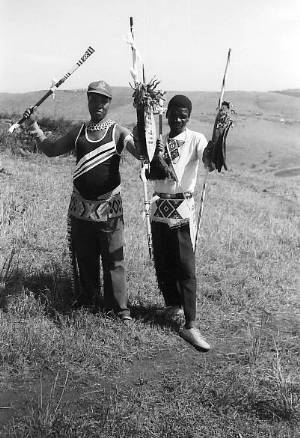
8a (3). Spectators and Officials
Spectators are always present during stick fights to acknowledge what happened (Mbanjwa, Interview, 1996), and to judge if the fight was fair (Fighting sticks, Episode 1, [S.a.]). Although spectators play an integral role in the proceedings of a stick fight, they are not to interfere with the fighting.
Spectators consist mainly of men and young unmarried women in traditional attire (Mamthetwa as cited by Zulu, Interview, 1996). Men whistle, women ululate, and the spectators generally show a verbal appreciation of exciting actions (Zulu, Interview, 1996). The reaction of spectators can enhance the performance of the fighters, and the fight is followed with great enthusiasm (Leitch, Interview, 1996).
Although the duties of the warrior captains, or umphathi wensiswa, include maintaining order during the fights (Leitch, 1996), Clegg (1981:9-14) believes that the umgangela cannot contain the tension between the districts. This can lead to violent encounters; hence the development of the isishameni style of dancing, which is today a more socially acceptable expression of conflict in KwaZulu-Natal. Leitch (Interview, 1996), with reference to KwaZulu, is of the opinion that the escalating violence in contemporary Zulu society is a direct result of the decline in the practice of stick fighting. Faction fighting can be seen as a modern manifestation of tensions between parties, but is by no means an acceptable method of resolving conflict through physical interaction (Ntuli, Interview, 1996).
The ritual combat of an umgangela is significantly different from faction fighting, during which induku and ubhoko are utilised as real weapons. Moreover, faction fights are not governed by the same rules as a stick fight: in faction fights, the intention is to cause harm and the fight erupts as an expression of aggression (Ntuli, Interview, 1996).
Leitch (Interview, 1996) indicates that since there is little restraint on the use of weapons in a faction fight, participants are not restricted to the use of induku and ubhoko. In contrast, Zulu (Interview, 1996) emphasises that no "meanness" should be involved in district fighting; the umgangela is an opportunity for "playing" and "peaceful fighting", and determining who the best fighter in the region is.
Ntuli (Interview, 1996) recalls that in his youth, "tribal wars" in the Gingingdlovo-Dokodweni (KwaZulu) area assumed the form of a stick fight.Regional stick fighting is still prevalent today in the Nongoma area (Zulu, Interview, 1996). Stick fights between people of Mtunzini and Durban also take place (Mbanjwa, Interview, 1996), although traditionally stick fighting was not as prominent in Natal as in KwaZulu (Clegg, Personal Conversation, 1996).
In any event, faction fights are armed brawls, whereas inter-district stick fighting is consciously a game, loaded with symbolism familiar to both the fighters and the observers.
8b. (1). Introduction
Most societies have rites of passage that are regarded as the "passport to adult status" (Elliot, 1978:142). Mlotshwa (1988:5) states that such rites of passage indicate the transition from one set of socially identified circumstances to another. They are concerned with personal development, and include the celebration of transitional stages in life such as birth, puberty, marriage, and death.
In Zulu society, the thomba or male puberty ceremony marks the "attainment of physical maturity, and the occasion is a very important one both for the individual and for his kraal [village]" (Mahlobo & Krige, 1934:166). Elliot (1978:142) is of the opinion that a puberty rite is not only significant in terms of its social function, but is also pivotal in a young man’s spiritual development. Stick fighting is a prominent element of male puberty rites, and so forms part of the symbolic passage of a male to the adult world. However, since Mahlobo & Krige (1934:166-181) analyse the thomba ceremony in detail, for the purposes of this article, a brief overview of selected aspects of the ceremony is all that is necessary.
The thomba ceremony starts after a boy experiences his first nocturnal emission, thus providing concrete evidence that he is entering a new phase of his life (Elliot, 1978:143). The boy follows a customary, set procedure to announce the event publicly. Firstly, he gets up before dawn, secretly steals his father’s cattle, and drives the herd to a place where they will not be easily located. The father, on noticing the missing cattle and son, announces the news and prepares the appropriate intelezi for the event. Secondly, the boy’s peers follow the example of stealing their fathers’ cattle and join the cattle with the stolen herd. As soon as the boy is found, the area around his stomach is smeared with "crab mud" and he must swim in nearby water (Mkhonza, 1984:19). Thirdly, the cattle must be found. Although Elliot (1978:143) acknowledges that differences exist among various clans, the observation provided is in accordance with the account given by Bryant (1949:654).
According to Elliot (1978:143), the first attempt to reclaim the cattle involves sending girls of the local kraals to return the boys and cattle home. Both girls and boys carry sticks and shields, and a stick fight erupts between the sexes. Gender roles are clearly delineated in the Zulu society, and stick fighting belongs to the sphere of the man (Ndaba, Interview, 1996). Since the socially ascribed gender role for women does not include warfare or martial arts (Ndaba, Interview, 1996), it is highly unusual to find instances where women wield the sticks. The thomba ceremony serves as an example of such an exception to the rule.
The fight presumably takes place in the space selected to hide the cattle. Elliot (1978:143) insists that the girls observed were experts with the fighting sticks, although they were eventually beaten in combat by the boys and chased home. Bryant, however, describes quite a different outcome of events:
Ritter (1957:16) states that both sticks and switches were employed in such a battle. Elliot (1978:143) argues that whipping switches were traditionally used, but were replaced by fighting sticks. On the supposedly rare occasion that the girls won, the boy reaching puberty was labelled a weakling (Elliot, 1978:143). Mahlobo & Krige (1934:157-1181) do not give an account of any practice similar to the fighting girls. It is thus difficult to determine whether the custom has its origin in ancient traditions, or whether it is a relatively modern development. Leitch (Interview, 1996) maintains that it is very seldom that girls fight the boys at a contemporary thomba ceremony, due to the decline of attention to the intricate details of the ritual.
If the girls did not succeed in recovering the stolen cattle, the fathers of the kraals go to fetch their cattle and boys. A stick fight between the boys and the men then takes place, usually with devastating consequences for the inexperienced boys. Once back at home, the boy undergoing the thomba ceremony is given intelezi and beer drinking begins. Further rituals take place over a number of days, and throughout the rest of the ceremony, the boy is constantly instructed on the appropriate patterns of social behaviour (Elliot, 1978:144).
It appears that participants in the ceremony are fully aware of the symbolic nature of their interactions. Furthermore, the playful subtext of the fighting actions is evident at all times. The boys are presumably engaged in sparring rather than actual stick fighting.
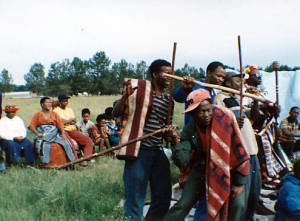
8b. (3). The Iphapu (Lung) Festival
During the iphapu (lung festival), stick fighting manifests itself in a highly organised format (Schoeman, 1982: 51).
Schoeman explains that participation in the iphapu festival is the sole privilege of herd boys. Herd boys are unmarried men and boys ranging in age from about 7-25 years. When a kraal slaughters a cow, certain parts of the beast are reserved for the herd boys only (1982:48). These parts include the heart, lungs (iphapu), and smaller fleshy parts of the animal such as the ears, spleen, and upper lip (Msimang, 1975:167). The lungs and the best meat received are not eaten in the kraal, but are taken away by the senior boy to a space specifically selected for the lung festival (Schoeman, 1982:48).
Strict criteria govern the selection of a suitable space. Schoeman (1982:48) identifies some of the determining factors. Firstly, the space should be located in an area high enough to keep a watchful eye on the surrounding area and possible enemies. Secondly, the space chosen should accommodate the need for privacy and safety of participants. Msimang (1975:166) points out that the area should be suitably private to play the game of stick fighting without being disturbed by the women of the kraal. Thirdly, a substantial amount of rocks should be available. The rocks are to be shifted around in order to produce a sound that is clearly audible throughout the surrounding area.
The sound functions as an invitation to the iphapu festival for other herd boys of the area. The boys drive their herds of cattle in the direction of the sound, and once assembled at the designated space, the younger boys are sent to collect wood for a fire. The boys barbecue the lungs, cut them into pieces, and distribute the pieces for consumption among the participants. Meanwhile, the izingqwele (senior boys) stuff the pleura with choice meat. The pleura are barbecued exclusively for the ingqwele (leader of the herd boys), and juniors only get a taste if a piece of the meat is offered to them as a reward for courage or bravery (Schoeman. 1882:48-49). Next they barbecue the heart of the animal, cut it to pieces, and divide the meat between the izingqwele (senior herd boys). Schoeman (1982:49) clarifies the action by providing a technical description of the procedure involved in eating the heart.
During the iphapu ceremony, juniors can challenge the leadership of their seniors. Boys from throughout the area gather to witness a challenge and acknowledge the victor as leader (Msimang, 1975:166). A challenge occurs within an accepted structure of events. Placing fat from the piece of lung reserved for the izingqwele on a stick and daring boys to take it away and eat it constitutes a challenge. The senior is expected to accept the challenge. Boys other than the most senior can turn down or ignore a challenge, unless the challenge is directed toward them by name, but by doing so, they acknowledge the current izingqwele as the undisputed leader (Schoeman, 1982:50-51). The izingqwele can also invent a reason for a youngster to go and see if all is well with the cattle. Upon his return, the youngster is told that another boy made inflammatory statements about him, or about his mother’s private parts. The statements might well have been made, but are very likely a fabrication. In either case, the boy is morally obliged to accept the challenge and initiate a fight.
A stick fight at the iphapu festival continues until a combatant emerges as the victor (Schoeman, 1982:50-51) or until one of the pair exclaims "khumu!" (Msimang, 1975:166), meaning, "It is enough". The spectators are fully involved in the fight, and the participants are enthusiastically encouraged and well-executed blows receive praise. Afterwards, the victor receives praise and applause from the whole congregation of boys, while the loser is subjected to playful jests and laughter.
Organised raids on the herds of cattle belonging to neighbouring kraals also take place during the lung festival. The intention of these raids is never to steal cattle. Instead, the intention is to create a playful scenario that provides a motivation for a stick fight.
These cattle raids have the potential of involving a large number of boys and young men in what is essentially a game of tactics. Firstly, a group of spies is selected from the younger boys participating in the festivities. The spies are then dispatched to establish when and how the raid will take place. The ingqwele may even accompany the boys on this expedition. Secondly, the cattle are brought to the grazing fields of the attackers. When the cattle are found missing, the victims arrive en masse to claim back their cattle, with the result being a stick fight. Should the victims lose the stick fight, then their cattle are not returned to them. Instead, they have to seek the assistance of older men, who negotiate with the attackers. The older men are supposed to be embarrassed by the actions of the youngsters, and will scold them thoroughly before attempting to retrieve the cattle. The cattle are given back to the men immediately upon their arrival, and the victims return home while enduring joking remarks from the attackers (Schoeman, 1982: 49-52).
After engagement in the necessary action, the cattle thieves return to their home kraal, where the rest of the meat (ears, lip and spleen) is eaten and washed down with Zulu beer (Msimang, 1975:166). It is highly probable that yet another fight between groups of boys will erupt after the general feasting back at home.
Schoeman (1982:52) claims that the highly structured and hierarchical nature of the programme gives rise to an almost political organisation among the herd boys. Authority flows down from the senior ingqwele to the izingqwele, and from the izingqwele to the ordinary herd boys. The organisation, the power structures, and the negotiations required following cattle raids are simply reflections of the power structures existing in the wider community.
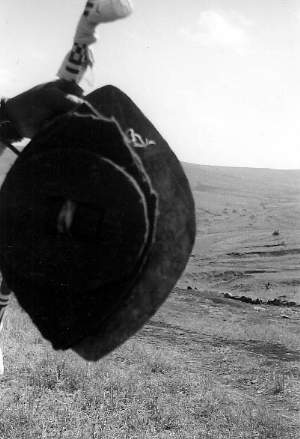
8c. Courtship
Traditional Zulu courting custom dictates that a boy should discover where the girl he admires collects water, and "waylay" her on her way to or from the water. A girl, or intombi, can accept or reject the boy’s advances by changing her customary route to the water. Should she have another admirer, then the boys may test their skill in stick fighting in an attempt to win her favour (Stewart, Interview, 1996). Ntuli (Interview, 1996) points out that the girl would always be present to observe the outcome of such a fight.
According to Stewart (Interview, 1996), the outcome of this contest might further develop into a fight between two groups of boys. This is most likely to occur if the loser is seriously aggrieved, or wishes to challenge the outcome of the fight. The loser will inform his friends about the fight, and provide a handy excuse for his weak performance. The loser’s friends might well be aware that the excuse is fictional, since it is generally accepted that the better stick fighter should win a stick fight. However, they willingly suspend their disbelief in order to have an opportunity to stick fight. The victor anticipates the loser’s actions, and in turn, notifies his friends about the fight that took place. Both parties then patiently wait for an appropriate opportunity (such as a wedding) to engage in a clash of arms, one party to restore its friend’s honour and impress the intombi, the other to again prove its superiority and impress the intombi.
Ntuli (Interview, 1996) believes that many stick fights are caused by rivalry for female attention. Stewart (Interview, 1996) points out that should a boy be too shy to confront a girl with his amorous advances, his sister or a female friend can come to his assistance and court the girl on his behalf. The female will dress in male attire, complete with induku, ubhoko, and ihawu. She might display arrogance or aggression (associated with masculine behaviour), and might even stick fight, although not to the extent that a boy would.
Additionally, a young man or boy might carry a stick heavily decorated with beadwork as an indication that he is interested in a particular girl. The stick is not utilised for fighting purposes, although it is carried with his fighting sticks (Shakaland, Home-video recording, 1996).
A Zulu wedding is a public event that takes place over a period of about three days (Dalrymple, 1983:121). It involves specific rituals in various stages of the ceremony that Dalrymple (1983:121-194) and Bryant (1949:533-604) have described in detail. Therefore, I will only pay attention to the role that stick fighting plays in the occasion.
Nowadays stick fighting often takes place before a wedding ceremony to settle any disputes between parties (Larlham, 1985:6). However, Mbanjwa (Interview, 1996) and Dalrymple (1983:131) indicate that stick fighting can also take place after the wedding ceremony. For example, the last afternoon of the wedding observed by Dalrymple (1983:121-131) concluded with older men drinking beer in the cattle enclosure while younger men fought with sticks.
Ntuli (Interview, 1996) indicates that stick fighting is an expected part of a Zulu wedding, and that participants will engage in a fight even if there are no disputes to be settled. Accordingly, men attend the wedding fully prepared for a stick fight. Young men might also decorate their bodies and their hair with beadwork, or dress up in beautiful pants and string vests to impress the girls present. Mzobe (Interview, 1996) notes that to this day, Zulu men often dress in traditional attire for a wedding, and even hire the appropriate clothes if they do not possess their own.
Stick fighting takes place at a wedding to impress the girls and to build a reputation as a stick fighter of calibre (Leitch, Interview, 1996). A man might even pretend to be interested in another man’s girlfriend to provoke a fight (Shakaland, Home-video recording, 1996). Alternatively, a man might intentionally overdress and appear very arrogant in order to anger other men (Stewart, Interview, 1996).
It seems that people at the wedding are aware of the playful dynamics operating in the attempts to provoke a stick fight, and go along with the game. Zulu (Interview, 1996) sees a wedding as an opportunity to "play umgangela", suggesting that the action is not an overly serious competition between men.
As always, a suitable space for the fighting is selected. This space must be in view of the wedding party, but not disturbing the proceedings. The warrior captain chooses the ground, usually situated on a hillside that overlooks the wedding. (Although level ground is preferable, steep slopes will not prevent a stick fight from taking place.) The place at which a stick fight happens is termed umgangelo, and spectators delineate its space by forming a human circle big enough to accommodate the action (Leitch, Interview, 1996).
To ensure correct protocol, the fighting takes place under the supervision of the warrior captains or leaders of the group. There is a specific structure in the flow of events. Firstly, people gather around the selected space and the men take turns to ukugiya. Larlham (1985:6) states that the performance of a ukugiya serves as a challenge to any man who wishes to display his prowess as a stick fighter. Dalrymple (1983: 160), however, indicates that a person who disrupts an ukugiyaat a Zulu wedding risks a stick fight. After the performance of a ukugiya, the challenge takes place.
Mzobe (Interview, 1996) points out that a man could challenge another by teasing him. At his sister’s wedding in 1995, Mzobe’s peers jokingly remarked that his lean physique would hinder him in a stick fight. Mzobe accepted this challenge in an attempt to prove his fighting skills. The challenge is unambiguous and clearly distinguishable from the action.
To begin the stick fight, a man from the opposite party accepts the challenge by taking a step forward. The resulting fight can incorporate comical elements designed to entertain the spectators and infuriate the opponent (Leitch, Interview, 1996). The reactions of the spectators vary according to the course that the fight takes. The spectators exclaim their delight at a good manoeuvre and watch quietly as the fight grows serious. Ululating girls assist in building the excitement, and perform their stamping dance (ukuggiza) (Larlham, 1985:8), thus encouraging the fighters to prove their superiority at stick fighting. As soon as a man is defeated, another from the opposition takes the stage. A great number of men can partake in the stick fighting depending on the following of the bridal parties (Stewart, Interview, 1996). Leitch (Interview, 1996) indicates that five or six hundred men can be engaged in the fighting, without any fatalities occurring.
Stick fighting at weddings has been discouraged of late, due to the serious nature of the injuries that might occur. Mafisa (Personal Communication, 1996) states that stick fighting at Zulu weddings is no longer a common practice, and only occurs in the rural areas.
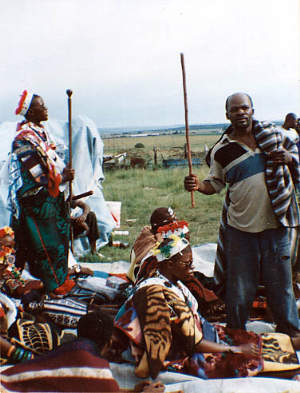
9. Conclusion
Traditional stick fighting, as performed in the rural areas of
KwaZulu-Natal, continues to serve as a process of socialisation, and to transmit
the social norms of the community in which it operates. In recent years, stick
fighting has become politicised to the extent that this practice, which once
played an instrumental role in building the pride of the Zulu nation, has come
to be regarded with contempt or suspicion by some. Contemporary practices of
stick fighting such as occurs in the hostels of mines, in the parks of
Johannesburg, or in the competitive team sport played by men travelling to
countries such as Japan, is a faint echo of the art’s traditional richness and
social importance. In a country historically associated with the violation and
exploitation of indigenous cultures in all spheres of life, vibrant arts such as
Zulu, Pedi, Xhosa, Sotho or Ndebele stick fighting are long awaiting the
recognition and respect that these arts deserve: fighting arts that are uniquely,
and proudly, South African.
Bibliography
ALEGI, P. 1997. Umlando Wemidlalo Emasendulo Eningizimu Afrika: The pre-colonial origin of soccer’s popularity in modern South Africa.http://people.bu.edu/palegi/imidlalo.html.
BECKER, P. 1964. Rule of fear: the life and times of Dingane king of the Zulu. London: Longmans.
BOFANA, M. 1997. Personal communication by Monica Bofana, domestic worker, Goedgedacht farm, Fochville, South Africa, January 29.
BROWN, D. 1998. Voicing the text: South African oral poetry and performance. Cape Town: Oxford University Press.
BRYANT, A.T. 1949. The Zulu people: as they were before the White Man came. Pietermaritzburg: Shuter & Shooter.
BUTHELEZI, V. 1996. Interview with Vusi Buthelezi, Herbalist, Dumazulu, South Africa.
CLEGG, J. 1981. Towards an understanding of African dance: the Zulu isishameni style. Unpublished paper, Symposium on Ethnomusicology, Rhodes University.
CLEGG, J. 1996. Personal telephone communication by Johnny Clegg, University of Zululand.
DALRYMPLE, L. 1983. Ritual performance and theatre with special reference to Zulu ceremonial. MA thesis, University of Natal, Durban.
DERWENT, S. Leitch, B., De La Harpe, R., and De La Harpe, P. 1998. Zulu. Cape Town: Struik Publishers.
ELLIOT, A. 1978. Sons of Zulu. Johannesburg: Collins.
GUNNER, L. & GWALA, M. 1994. Musho: Zulu popular praises. Second edition. Johannesburg: Witwatersrand University Press.
KAVANAGH, R. M. (ed.). 1992. South African people's plays: ons phola hi. Johannesburg: Heinemann.
KRIGE, E. J. 1965. The social system of the Zulus. Second edition. Pietermaritzburg: Shuter & Shooter.
KROG, A. 1994. Stokveg. Die Suid Afrikaan, October: 42-43.
LABAND, J. 1995. Rope of sand. Jeppestown: Jonathan Ball Publishers.
LARLHAM, P. 1985. Black theatre, dance and ritual in South Africa. Michigan: UMI Research Press.
LEITCH, B. [S.a.]. Fighting sticks. Video. SABC Production.
LEITCH, B. 1996. Zulu stick fighting. Personal interview. Umhlali, South Africa.
MAFISA, T. 1996. Personal communication by Tankiso Mafisa, Honours student, University of Zululand.
MAHLOBO, G.W.K. & KRIGE, E.J. 1934. Transition from childhood to adulthood amongst the Zulus. Bantu Studies, VIII (2), June: 157-191.
MBANJWA, M. 1996. Zulu stick fighting. Personal interview. Mtunzini, South Africa.
MBHENSE, D. 1996. Interview with Dumisani Mbhense, third year student, University of Zululand.
MKHONZA, M.F. 1984. A brief analysis of Zulu drama. Honours thesis, University of Zululand.
MLOTSHWA, N. 1984. A study of diverging and converging points between ritual drama and contemporary drama with special reference to Zulu rituals. Honours thesis, University of Zululand.
MNQAYI, P. 1998. Ukungcweka. Personal explorations. University of Zululand.
MSIMANG, C. 1975. Kusadliwa ngoludala. Pietermaritzburg: Shuter & Shooter.
MUTHWA, C. 1992. uNosilimela. In: Kavanagh, R. M. (ed.). South African people's plays: ons phola hi. Johannesburg: Heinemann: 5-61.
MZIMELA, B.M. 1990. A brief survey of Zulu warfare vocabulary and its literary contribution to the Zulu language. Unpublished research essay, University of Zululand.
MZOBE, S. 1996. Zulu stick fighting. Personal interview. University of Zululand.
NDABA, J. 1996. Zulu stick fighting. Personal interview. University of Zululand.
NTULI, J. H. 1996. Zulu stick fighting. Personal interview. University of Zululand.
POOLEY, E. 1993. The complete field guide to the trees of Natal, Zululand and Transkei. Durban: Natal Flora Publications.
RITTER, E. A. 1960. Shaka Zulu: the rise of the Zulu empire. London: Longmans.
SCHECHNER, R. 1985. Performance studies. London: Routledge.
SHAKALAND. 1996. Zulu stick fighting. Home-video recording.
SCHOEMAN, H.S. 1982. Spel in die kultuur van sekere Natalse Nguni. Pretoria: Universiteit van Suid-Afrika.
SOTHO, Lebhulo. 1997. Personal observation, Goedgedacht farm, Fochville, 29 January.
STEWART, G. 1996. Zulu stick fighting. Personal interview. Hluhluwe, South Africa.
TYRELL, B. & JURGENS, P. 1983. African heritage. Johannesburg: Macmillan South Africa.
WERNER, A. 1933. Africa: myths and legends. London: George G Harrap & Co.
ZULU, M. 1996. Zulu stick fighting. Personal interview. Nongoma, South Africa.
Information was also obtained by observing informal stick fights whilst based at the University of Zululand (1994-2000).
Endnotes
EN1. Providing Western names for these trees is problematic, as amongst other difficulties, the names vary according to regions and dialects. uMquambathi, or protea roupellia, is commonly known as the silver sugarbush. It is found in Zululand and the Transkei (Pooley, 1993:86). uMazwende, or artabotrys monteiroae, is commonly found in northern Zululand, where it is known as the red hook-berry tree (Pooley, 1993:94). uMazwende can also refer to the uMazwende-omlhope tree, or monanthotaxis craffa, which is renowned for its magical properties. This latter tree is commonly called the dwaba berry (Pooley, 1993:94). The ibelendlovu tree, kigela africana, is popularly identified as the sausage tree. Its wood is not very hard, but it is tough (Pooley, 1993:94). uMphahla is a tree from the Brachylaena species, and umthathe or ptaeroxylon obliquum is generally referred to as the sneezewood tree (Pooley, 1993:448). Available Western botanical resources do not list uMunquma.
EN2. The induku is also called umshiza, umzaca, isikhwili, isiqwayi, imviko, and umqambathi, depending on the regional discourse (Mzimela, 1990:21). For example, informants in Nongoma favour the name isikhwili, while informants in Mtunzini and Hluhluwe favour the name induku.
EN3. The action of striking with induku can be called ukugadla, ukushaya, ukubhonya, ukuqunsula, or ukuvithiza (Mzimela, 1990:21).
EN4. uPhindamshaye, or the adenia gummifera, is a poisonous climber often used for medicinal purposes (Pooley, 1993:338). The phind’umuva is an unfamiliar species of plant, identified as a creeper by Buthelezi (Interview, 1996). Cene seems to be a generalised term indicative of a number of small aloes.
Dr. Marié-Heleen Coetzee lectures at the drama department of the University of Pretoria in stage movement, educational drama and theatre, and drama and film studies. She was previously on faculty at the University of Zululand (1994-2000). Whilst based in Zululand, her research focused on the cultural-anthropological and physical dynamics of Zulu stick fighting and its application to theatre. Most of her research on the cultural-anthropological aspects of stick fighting was conducted and documented between 1995-1996 as part of the research project "Playing Sticks: An Exploration of Zulu stick fighting as performance". She has addressed national and international conferences on her field of study, taught at national and international stage combat workshops, and published academically. Additionally, she has directed, performed in, and choreographed various theatrical productions. She serves on the executive board of the South African Performers’ Voice and Movement Educators (SAPVAME) and on the Artistic Advisory Committee of the International Organisation of the Sword and the Pen (IOSP). She initiated and organizes the annual "Rendezvous South Africa!" international stage combat workshops.

Untying The Past. Rapping Up The Present. Preparing The Future
BONA Magazine – December 1988 http://www.3rdearmusic.com/reissue/siphomchunu.html
By AMOS MNGOMA - Photographs by DAVE ELLINGER (P)© BONA 1988
Sipho Mchunu is a brave man. Two years ago he broke with partner Johnny Clegg to be with his large family and to till the soil. Juluka was no more.
During that period he saw just about everything he had worked for go up in flames. He also saw Johnny Clegg and his new group, Savuka reach great heights in the music world both locally and overseas.
Sipho is brave. After all the trials and tribulations that befell him, he's decided to make another go of his musical career.
Slowly the Mchunu family has pieced together their lives, and Sipho feels the time is right for a comeback. "I'm going for traditional music”, he said. "I want to give my friends here and overseas the real African message, deep from the roots of our tradition, not just a meaningless mixture of African / Western beat.
At the time of writing Sipho and his new group uSipho noThukela were frantically rehearsing for a short tour of the USA, where they were due to take part in an African traditional music festival.
Sipho told me from his home on the banks of the Tugela (Thukela) River that his reported teaming up with Clegg would not interfere with Savuka.
"It would be unfair of me to try to join them after all the work they have put into the group and after they have achieved so much," he said. “However, he still wanted a meeting with Clegg to finalise the Juluka question.
Said Sipho. "Juluka must not die. Johnny and I could meet and perform as Juluka from time to time if our fans wanted this, supported by members of our groups, and then go our separate ways. Juluka is Sipho Mchunu and Jonathan Clegg".
Sipho is still counting the cost of his tragic losses during the past two years. Faction fighting in the area destroyed his homes, furniture and vehicles. (Valued at about R135 000 in 1988).
He also lost about 100 head of cattle, either butchered or stolen. Fortunately however, the school he built for the children of his community was untouched."
Slowly the Mchunu family has pieced together their lives, and Sipho feels the time is right for a comeback. "I'm going for traditional music”, he said. "I want to give my friends here and overseas the real African message, deep from the roots of our tradition, not just a meaningless mixture of African / Western beat.
My songs are based on real events and places in Zulu history." In spite of the hard times after Juluka split, Sipho does not regret his two-year break from music. "No matter how successful I am in music I will still dream of tilling the land."
SIPHO Mchunu became synonymous with young Yeoville Zulu Blanke, JOHNNY Clegg in the 1970’s. It wasn’t easy for Sipho Mchunu or Johnny Clegg to perform their special brand of Maskandi Magic & Music just anywhere.
3rd Ear Music’s Tribal Blues in 1971, or the odd Folk Festival & our Free Peoples Concerts (1971 to 1976 and 1980 to 1986) at Wits University – organized with NUSAS (National Union of SAfrican Students) & SAFMA (South African Folk Music Association) - presented these talented young Folk & their various Zulu Dance groups (waMadhlebe) & Bands (Juluka) to a wider suburban & city audience.
Post 1973 in the townships, it was a different story. Juluka were a phenomena on the other side of the tracks - a world that few in the suburbs were aware of.
So tell me, I heard at the time & still hear 30 years later, if they were so damn good how come they didn’t sell? Where are the chart figures?
Sell what? How? Where? (See why we think this Hidden Years Archive & the hopeful hidden history it holds is important?)
How misinformed are today’s New Age Digital Media Jocks? We aren’t making any lame excuses - what happened, happened. But isn’t that question a little like asking why, if Bishop Tutu were so popular, wasn’t he President of South Africa in 1976?
35 years on & Sipho & quite a number of other 3rd Ear Musicians, are still around making music. They have survived in spite of not selling well? One wonders, in sympathy at times, where those DJ Radio personalities, the programmers & Political
Gate-Keepers are today & how they will, if ever, be remembered? History, hidden or not, will survive if it passes the ultimate taste test - time. All we have to do is listen. What a pleasure!
But even if musicians did manage to produce a recording back then & sell well – who in their particular segregated mainstream media would ever have known without a little foreign intervention? For example, in the 70’s when 3rd Ear presented groups such as Ladysmith Black Mambazo in the city, few non-blacks had ever heard of them. Yet they were already the biggest selling recording group in Africa. They outsold the Beatles, Elvis & Sinatra put together. LBM did not top any pop charts internal or external,… until Paul Simon heard the light 15 years later.
 Sipho
& Johnny started performing in public as a duo in 1970 & at times appearing with
their impressive (32 member) nDlamu Dance group, waMadhlebe - comprised of Zulu
Gold Mine migrant Hostel dwellers. People flocked to these amazing events - if
they managed to hear about them. And marketing an event like that was in itself
an achievement. The events were always free, but for passing the hat, which
sometimes disappeared. (We heard some years later that at one or two Free
Peoples Concerts (Wits 1971 to 1976) that it was a Security Policeman who needed
some petty cash?)
Sipho
& Johnny started performing in public as a duo in 1970 & at times appearing with
their impressive (32 member) nDlamu Dance group, waMadhlebe - comprised of Zulu
Gold Mine migrant Hostel dwellers. People flocked to these amazing events - if
they managed to hear about them. And marketing an event like that was in itself
an achievement. The events were always free, but for passing the hat, which
sometimes disappeared. (We heard some years later that at one or two Free
Peoples Concerts (Wits 1971 to 1976) that it was a Security Policeman who needed
some petty cash?)
Not to arouse the suspicions (and paranoia) of the authorities, required some ingenuity & a whole load of word of mouth. It was one thing (and illegal) to have different races dancing or being entertained together, but it another thing to do so on the sacred Sabbath Sunday! A few discreetly placed handbills & street posters (usually in the darker side of town - Hillbrow & Yeoville with the occasional preview in the Rand Daily Mail & The Star – & later in Die Beeld en Rapport – all helped to attract people with minimum official or state attention. And when it did attract attention, the following gigs were cancelled (sometimes mysteriously – sorry, you weren’t booked here – must be a misunderstanding!)
3rd Ear Music Notes 1990 - Sipho & his band set New York alight when he performed these new songs at the famed Apollo Theatre in 1988. However, back home – and despite his legendary status, Radio uKhozi (Radio Zulu at the time)‘declined’ to program or promote umHlaba uZobuya. TUSK Records & 3rd Ear Music had plans for a short Zululand tour. to raise income for Sipho’s losses in the Makhabaleni faction fights. A popular DJ told our PR people that the only way Radio Bantu would Programme the album & mention Sipho’s proposed concerts was if we put R5 000 on the table & parted with 50% of the gate for each concert. No joke! What can we do, said the grey-haired impeccably straight Station Manager to whom we reported the incident? The CID is investigating, he confided... the DJs are power. Mess with them & we loose our (captive?) audience & the sponsors as well. Radio Zulu had over 5 million listeners ...... 11 years after liberation you’ll never hear the likes of Sipho Mchunu (or any 3rd Ear Musician) on East Coast Radio. And check out who the share holders are! Strange, strange world indeed.
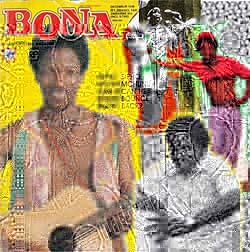 |
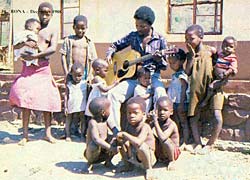 Sipho sings to his children at his kraal 1988 |
| BONA Magazine 1988 & 3rd Ear Collage | |
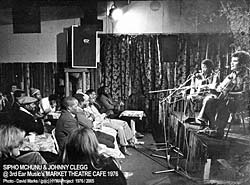
SIPHO MCHUNU & JOHNNY CLEGG @ 3rd Ear Music’s
MARKET THEATRE CAFE 1976
Photo - David Marks |
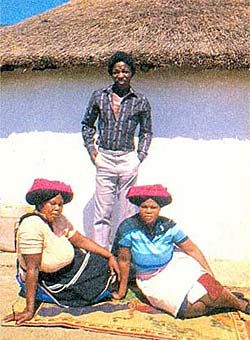
SIPHO has a large family . Here he is (above)
with 2 of his 5 wives. (Right) The only ‘status’ symbol that
Sipho has after the loss of property & possessions through
faction fights. He also lost about 100 head of cattle, either
butchered or stolen. Fortunately however, the school he built
for the children of his community was untouched."
|
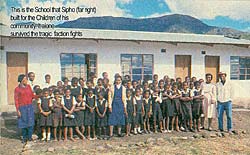
This is the School that Sipho (far right) built
for the Children of his community. It alone survived the tragic
faction fights.
|
|
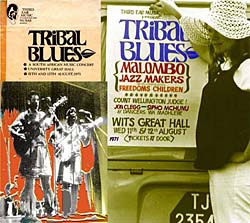 |
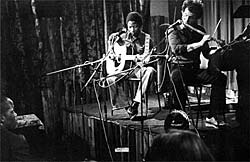
SIPHO guitar & vocals with JOHNNY playing the
uMphe Bow 3rd Ear Music’s MARKET THEATRE CAFE 1976 (Photo: David
Marks Hidden Years Music Archive Project)
|
| Tribal Blues Programme & Poster with Fran Wits 1971 |
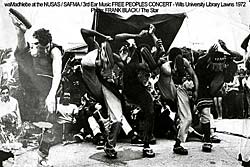 Sipho & Johnny waMadhlebe Free Peoples Concert 1972 |
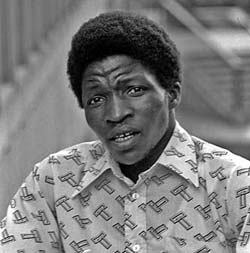
A Young Teenage Sipho Serious
|
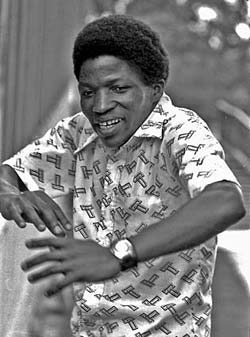
A Young Teenage Sipho Dances
|
3rd Ear Music Company est. 1969 (Pty)Ltd. The Hidden Years Music Archive
Project
P.O.Box 50633 - Musgrave 4062 - Durban - KwaZulu-Natal - South Africa -
email:
thirdear@iafrica.com
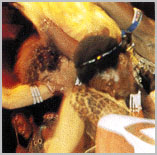 Worlds
Apart: Johnny Clegg Has Been Molded by South Africa
Worlds
Apart: Johnny Clegg Has Been Molded by South AfricaGreg Kot, Chicago Tribune
http://www.talkingleaves.com/articles/worlds.html
April 29, 1990
World beat, the catch-all term for non-Western pop music, first reached a wider
audience in America thanks to Paul Simon`s 1986 ``Graceland`` album. But long
before Simon began cross-pollinating the rhythms of distant continents, Johnny
Clegg, a white South African, was forging a musical bond between his Zulu
brethren and his Western ancestors.
More importantly, where Simon created a pop hit with his record and then went on to other styles of music, Clegg is building musical bridges to and from South Africa for the long term.
"I am shaped by South Africa," he says in a recent phone interview from Los Angeles. "Much of what I am, what I need, is in that country. It is a prison and a wombthat contradiction is what draws me there."
Clegg, who will open for Tracy Chapman at Alpine Valley June 9 and Poplar Creek June 10, was born in Manchester, England, but reared in Johannesburg. In his teens, he forged a lifelong-and illegal-alliance with his Zulu neighbors, slipping into the black townships to learn their language, music, dances and customs.
With one of his black friends, he formed a band, Juluka (which means "sweat" in Zulu), in 1976. Its mix of black and white styles and musicians became a political statement in itself, an interracial affront to apartheid. Until it broke up in 1985, Juluka was one of the most popular bands in South Africa, with five gold and two platinum albums.
Each contained songs that were banned on the government-sponsored radio station because they openly questioned the status quo. Clegg`s concerts, many of which played to mixed audiences around the black ghetto of Soweto, were frequently broken up by police.
Though Westerners may believe that the situation in South Africa has eased since black opposition leader Nelson Mandela was released from prison, Clegg says, "It`s still tense-the context is getting better, but the events themselves are still dark and brutal.
"We still have a state of emergency, and music is still seen as an undermining force. I haven`t had a show stopped since March, 1989, but the threat is still there."
As if to emphasize that the old days of repression haven`t ended, Clegg`s new single, One (Hu)Man One Vote, was banned by the South African Broadcast Corp.
As the lead track on Clegg`s new album, Cruel, Crazy, Beautiful World (Capitol), it is perhaps his most far-reaching political statement yet, a state-of-the-world address that begins by challenging Americans:
"The right to vote has become a hassle for a lot of people in the West, it`s taken for granted," Clegg says. "With One Man, I tried to emphasize that this is a universal right that people fight and die for in other parts of the world."
Although previous albums spoke to the black community, Clegg acknowledges that young whites are making up a larger share of his audiences back home. That`s fine with him, because white attitudes are the ones he`s trying to change.
But as much as his music is political, Clegg isn`t in the business of politics. He brushes off the mantle of "spokesman" that some critics choose to hang on him.
"It`s very important to understand that I`m not a spokesman for South Africa; all I`m doing is describing the South African experience," he says. "There are already too many politicians in South Africa; it doesn`t need another."
Indeed, much of Clegg`s popularity in his homeland rests on his energetic live performances. With his new band, Savuka (which translates to "we are risen"), pounding out wave after wave of joyful, cross-cutting rhythms, Clegg often breaks into traditional Zulu warrior dances with black percussionist Dudu Zulu. When they collapse on stage, triumphant after metaphorically stomping on segregation and repression, their audiences roar with approval.
When he`s not dancing himself to exhaustion, Clegg`s voice combines the keening ache of Celtic music with the warbling intensity of the black South African choirs.
"I`ve been experimenting with my voice, looking for more emotional textures," he says. "Celtic music has a romantic appeal, because it reminds me of my father, whom I`ve never seen. It`s a connection with part of my past."
When Clegg was only a year old, his English father left home and was never seen again. His mother then moved with Johnny to Zimbabwe and later Johannesburg, which has become home.
Its beauty and brutality have shaped Clegg`s life and art, never more so than on his new album, a mirror of a "cruel, crazy, beautiful" land.
Clegg, who speaks fluent Zulu, married his wife in a traditional white Christian church ceremony and also followed Zulu custom, "marrying" her again after she gave birth to their son, a ritual documented on the joyful Moliva.
"It wasn`t a political act or a media event," Clegg says. "It was a celebration of my son`s birth with the community I grew up with."
Moliva epitomized the tone of the album as Clegg began recording last spring in Los Angeles. "I felt good, up, positive," he says.
Then, in the middle of the session, his friend and fellow anti-apartheid activist, university professor David Webster, was assassinated in Johannesburg.
"I came back from the funeral and my mood was completely different,`` Clegg says. "I wrote three songs Woman Be My Country, Cruel, Crazy, Beautiful World` and One (Hu)Man One Vote that represented a complete break from the other songs. The album went from being upbeat and humorous to angry and desperate within a matter of days."
Clegg will carry these emotional postcards from his homeland around the world on a 10-month tour, which will play Europe, North and South America, Australia, the Far East and finally the Soviet Union.
"I believe that a solution in South Africa is within our grasp," Clegg says. "But what I hope my music will do is show people that what goes on in South Africa is not just South Africa`s problem."
It`s why Clegg`s album includes songs such as Warsaw 1943, inspired by the writings of Polish poet Czeslaw Milosz. It tells a tale in both English and Zulu of betrayal and friendship during the Jewish ghetto uprising against the Nazis in World II.
"Our world struggle is not unique in South Africa," Clegg explains. "What is happening back home has been happening all around the world for centuries and Poland struggling under the Nazis and then the Soviets is just one example of that."
With political change occurring almost daily around the world in the last year-China`s Tiananmen Square uprising, Lithuania`s break with the Soviet Union, the fall of the Berlin Wall-Clegg sees the world at a crossroads, as he sings on One (Hu)Man One Vote:
"In a world with a 21st Century technology base, an 18th Century morality and a 16th Century religion, we are trying to shape an image of man that is universal," Clegg says. "If that image is disturbed by one country, that image cannot exist."
Humphrey Tyler: COMMENT 13
January 2006 12:00
http://www.mg.co.za/articlePage.aspx?articleid=261253&area=/insight/insight__comment_and_analysis/
13
January 2006 12:00
http://www.mg.co.za/articlePage.aspx?articleid=261253&area=/insight/insight__comment_and_analysis/
For a couple of minutes on a day not long ago, I felt like I was back in the States.
It was dusk, that perfect time of evening here when the burning-bright sun dips below the hills but leaves its soft warmth to play just a bit longer under the graying sky.
On a large, sloping lawn in my favorite city park, hundreds of families had set up picnic blankets facing a temporary concert stage. Children bounced with the music. Parents opened wicker baskets and uncorked wine bottles, chatting with each other in the fading light.
It was the Outdoor Summer Concert, so recognizable, so American.
But of course, nothing stays familiar here for long. It's part of South Africa's dance, how the country lulls you into believing you're home and then suddenly unmasks itself, leaving you bewildered, depressed, delighted. It shows that this is not just a different country but a country in a different time and place, a nation moving dizzyingly forward, backward and sideways as it pulls itself from its recent, horrendous past.
This time, the shift came when Johnny Clegg appeared on stage.Clegg is well known here. In the late 1970s, he formed the band Juluka with his friend Sipho Mchunu. It was a collaboration totally unacceptable to the apartheid government.
Clegg is white - he was born in England, grew up in Zimbabwe and then moved as a young teen with his mother and stepfather to South Africa. Mchunu is black, a Zulu. Their music was pure integration - a combination of Zulu rhythms and English lyrics, Western melodies and traditional African dancing.
In 1980, South African radio banned them. But the two kept singing and won fans across the country and in Europe. When Mchunu and Clegg split in the mid-1980s, Clegg started the band Savuka and became an international star. In France, where he was hugely popular, he was dubbed "the white Zulu."
Now, 11 years after the end of apartheid, here he was - standing in this well-tended Johannesburg park, a symbol of this country's aspired-to cultural mixing and Rainbow Nation hope.
He began by singing "African Sky Blue"-African sky blue, your children wait for the dawn; African sky blue, soon a new day will be born.
By the time he pounded the angry chords of "Third World Child"-They said, I should learn to speak a little bit of English; Don't be scared of a suit and tie; Learn to walk in the dreams of the foreigner; I am a Third World Child- the blankets were trampled and the picnic-goers were on their feet, singing, stomping, cheering.
They seemed to be clinging to the band, to Clegg, to this peaceful, exciting togetherness. They screamed for the Zulu warrior dancers who joined Clegg on stage, shouted the Zulu lyrics, fists held in the air.
It was desperate unity, and so easy.
But I couldn't help but notice that around me, most of the people were white.
It's Zulu-light, a friend of mine said dryly afterward. If you're a white Johnny Clegg fan, he said, then you're absolved of your sins. You can be a part of the New South Africa without ever talking to a black person.
New challenges
But what is this New South Africa? People sometimes ask why we write about this country, now that apartheid is over and Nelson Mandela isn't even president anymore.
To me, the answer seems obvious.
Not so long ago, South Africa was in the midst of ethnic warfare, with secret police and torture sessions and sabotage bombings.
Blacks killed blacks, as well: Suspected informants in the townships were given the "necklace," a burning tire thrown over their necks. And after Mandela, who is from the Xhosa tribe, was released from prison in 1990, clashes between his party, the African National Congress, and the predominantly Zulu Inkatha Freedom Party left thousands dead.
It was the same ethnic hatred we have seen throughout the recent, brutal decades - in Kosovo and Israel, Iraq and Rwanda.
South Africa's response was different. Instead of genocide or war or international tribunals, South Africa chose "Truth and Reconciliation," the concept of justice without vengeance. Now the nation is generally peaceful and confident - a lesson for the world, proof that the depressing quagmires of human hatred are not, in fact, hopeless.
But South Africa's evolution is not over. We should watch how -or whether - this country of hope deals with its new challenges, such as horrible economic disparity, the deadly onslaught of HIV-AIDS and a population that still seems racially divided.
Many people here seem to want true reconciliation - not just the abandonment of hate but a real fusion of cultures. It certainly seemed that way from the adoring crowd at the Johnny Clegg concert.
But it's easy to cheer for Johnny, to be moved by his story and his music. It's harder to learn Zulu and to accept what his lyrics about inequality say about our own lives in the walled, white suburbs.
As much as South Africa is a miracle in how far it has evolved since the violence, there is also something trapped and traumatized about this place.
Crazy?
The other day, a friend watched an upscale pizza restaurant get held up by men with AK-47s. It was a place not far from our house, on a posh little strip of outdoor cafes and boutiques.
At the bar across the street, my friend and the happy-hour crowd watched from the balcony as the pizzeria diners lay on the floor, hands behind their heads. Some minutes later, the robbers fled without injuring anyone.
The people at the bar started to laugh. And the people at the restaurant got up to finish their meals.
Well, of course, said a white South African woman I met at a dinner party. What else are you going to do?
She continued, telling a tale of her own about somebody's gun going off, narrowly missing someone else, how there was only minor bloodshed and how the whole scene was absolutely hilarious.
They're crazy here, I said to my husband as we drove home. Totally nuts.
But maybe it's not crazy. Maybe it's just a country that is evolving and contradictory and fascinating.
In the newspapers, for instance, we read about angry wage protests, about massive strikes, about impoverished blacks furious at the black-led government they believe has done little to help them. We read about the increased number of BMWs sold to "buppies," the new black yuppies, and about Black Economic Empowerment deals - the aggressive South African version of corporate affirmative action.
There are articles on outrageous robberies at upscale malls - usually involving a dozen attackers and absurd numbers of guns -and on the hot real estate market. There are stories about witchcraft and traditional healers and virginity testing, about distribution programs for anti-AIDS drugs and the health minister who still says HIV is best treated with olive oil and garlic.
Raw
We hear tales from whites who say there is no future for them in this country, that all the jobs and money are going to black people. And we go to upscale restaurants that are filled with whites, and walk through neighborhoods where black gardeners and nannies are the only other people outside the walls.
It is mind-spinning, and raw.
It would be so easy if this country's experiment worked like Johnny's band.
When he finished the last set that night, Clegg leaned into the microphone. I'm proud, he said, to have been part of this country. And proud to be able to grow with it, as it changes.
The concert-goers cheered again.
My friend was right. It was easy to applaud, with the country's problems feeling so far away on this gorgeous night in this pretty park.
Still, it was a mob of white people cheering for the integrated, New South Africa.
And that offers hope. No matter what else is happening in this astonishing, overwhelming country.
(Stephanie Hanes, a former Monitor reporter, is a freelance writer living in South Africa. Her husband, Scott Calvert, also a former Monitor reporter, covers Africa for the Baltimore Sun.)
BONGANI MTHETHWA 2006/01/29 12:00:00 AM http://www.suntimes.co.za/Articles/TarkArticle.aspx?ID=1870467
A BITTER feud between a former Juluka band member and a tribal chief is threatening development in rural KwaZulu-Natal.
The dispute between guitarist Sipho Mchunu and chief Muntukaboni Dlomo has stalled a much-needed investment in Emakhabeleni near Kranskop in the Midlands. This week, Dlomo pulled the plug on an empowerment deal — brokered by Mchunu’s partner in Juluka, Johnny Clegg, on Mchunu’s behalf — to build a cultural lodge on the banks of the Uthukela River.
Dlomo, who had initially approved the project, said he could not allow it to go ahead if “Mchunu persists with stealing cattle”.
The project would create job opportunities for local people and 75% of the profits would go to the Makhabeleni Tribal Trust. Both Mchunu and Dlomo would also have a stake in it.
Clegg, who has been shuttling between his home in Johannesburg and Emakhabeleni in a bid to facilitate reconciliation between the two, said the deal had been close to being finalised.
“The funders are not interested in funding an area where there is this kind of tension and that’s why I participated to try to heal the rift between the two,” said Clegg.
The animosity reached new heights after Dlomo appeared briefly in the Kranskop Magistrate’s Court on assault charges — and immediately gave Mchunu an ultimatum to stop his cattle-farming business or face the wrath of the community.
“The only way to remedy the situation is for him [Mchunu] to stop selling the cattle altogether or the community will be forced to take action,” said Dlomo.
At the heart of the conflict appear to be Mchunu’s burgeoning business and allegations that its success is based on stock theft in the area.
Things worsened in August when Mkhaba Zondi was accosted by members of the community while allegedly herding cattle towards Mchunu’s homestead. Zondi was hauled before a tribal court where, according to Dlomo, he confessed he was going to sell the stolen cattle to Mchunu. The severely beaten Zondi was rescued by the police after being held for four days at Dlomo’s homestead.
Local police have denied that stock theft is rife in the area and have said no charges have been laid against Mchunu.
Dlomo, 54, along with his brothers Sakhiseni and Dumisani, local induna Mlingeni Gasa and his brother Busani have since been charged with assault.
But behind the cattle-rustling allegations lies a war between two men who were once friends but now see each other as contenders in a battle for influence.
Positions on the root cause of their feud differ. To some, Mchunu is a victim of jealousy because of his successes.
“He is very respected at Emakhabeleni but since these rumours started his reputation has been dented,” said Sukumile Gasa. “This is very sad because when there was faction-fighting in this area Mchunu fought for this community.”
To others, he is an arrogant cattle rustler who has no regard for the chieftaincy.
Mchunu and Dlomo stay about 500m apart but are not on speaking terms. By contrast, in the mid-’80s Mchunu played a major role in defusing tensions around the chieftaincy and the subsequent installation of Dlomo as a chief. The musician’s homestead was burnt down, his cattle stolen, and five vehicles and his irrigation system destroyed during the clashes.
A self-taught guitarist who grew up as a herdsman, Mchunu was catapulted to stardom after teaming up with Clegg to form Juluka, which later became an international name. He ploughed money back into his community by building a school in 1985.
But soon afterwards talk started circulating in the area that he harboured ambitions of becoming a chief — a claim Mchunu has rejected.
“I don’t have any problem with the chief and he is well aware of that. The chief and a small coterie of his supporters have actively sought to promote the idea that somehow I’m conducting my business affairs like a criminal,” he said.
Juluka band member out on R500 bail
May 04, 2006, 13:00 http://www.sabcnews.com/south_africa/crime1justice/0,2172,126781,00.htmlMusician Sipho Mchunu, the co-founder of Juluka with Johnny Clegg, has
appeared at the Kranskop Magistrate Court in KwaZulu-Natal on charges of stock
theft.
Mchunu was arrested yesterday. He has been released on R500 bail and will appear
again on the May 18. Prosecutor Sindi Nkomonde says the postponement will allow
further investigations to take place.
http://www.tectonic.co.za/view.php?id=963 12 April, 2006
James Gosling, the father of Java, will be in
Johannesburg, South Africa for Sun Tech Days on 3 to 4 May. Tectonic
catches up with him to chat about Java, open source, and his favourite South
African singer.
....
JNY: When you're in South Africa, are you planning on doing any
travelling?
JG: I would love to. I'd love to go on a photo safari, see if there's a
Johnny Clegg concert (I'm a big fan), tour around... But I can't: JavaOne is
coming up real soon and, unfortunately, I have no time for fun.
von Irmgard Schreiber
http://www.az.com.na/index.php?page=news/news.php&identifier=1079864025&id=15095
13. April 2006
Windhoek - Nach Auftritten in New York, Nashville und London
zieht es den südafrikanischen Folkrock-Musiker Robin Auld nach Windhoek: Vom 26.
bis 29. April tritt er gemeinsam mit Barry van Zyl, dem Schlagzeuger von Johnny
Clegg und Savuka, im Warehouse Theatre auf.
Auld, der in seiner über 20-jährigen Musikkarriere mehr als acht Alben sowohl in
Südafrika als auch in Übersee veröffentlicht hat, ist nach langjährigem
Aufenthalt in England kürzlich in seine Heimat Südafrika zurückgekehrt. Man
kennt ihn durch seine Hits ,,Love Kills", ,,Long Lost" und ,,All of Woman".
Robin Auld definiert seinen Stil ,,irgendwo in der Richtung von Crowded House
und Ben Harper". Die Presse beschreibt seine Musik so: ,,It hops from folkrock
to pure pop to African-tinged licks to Celtic tricks with ease". Oder: ,,It´s
wife´s-making-the-slaai-I´m-turning-the-braai?
will-for-sure-sound-good-life-music."
Nachdem Auld im vergangenen Jahr sein neues internationales Album ,,Diamond of
the Day" (2005) in England vermarktet hatte, ist nun die Zeit gekommen für einen
lange gehegten Plan: auf Tournee zu gehen mit Barry van Zyl. Auld und Van Zyl
waren sich regelmäßig auf Festivals begegnet, hatten nach ihren separaten
Auftritten gemeinsame Jam-Sessions backstage und sprachen über eine
Zusammenarbeit, für die es nie wirklich Zeit gab. Nun, da von Zyl eine Pause von
seinem anspruchsvollen Job als Schlagzeuger von Johnny Clegg einlegt, ist die
Zeit für das gemeinsame Musikprojekt gekommen. Auftritte in Windhoek: von
Mittwoch, 26. April, bis Samstag, 29. April, 21 Uhr im Warehouse Theatre. Karten
im VVK beim Warehouse: N$ 55, AK N$ 65.
von Irmgard Schreiber http://www.az.com.na/index.php?page=news/news.php&identifier=1079864025&id=15262
Es ist nicht einfach, mit nur drei Mann eine gute, lebendige Show im Warehouse Theatre auf die Beine zu stellen, aber Robin Auld und seinem Team ist das eindeutig gelungen. Das Trio, bestehend aus Sänger und Gitarrist Auld, Schlagzeuger Barry van Zyl, der sonst für Johnny Clegg & Savuka spielt, und Bassist Skalk Joubert, will auch noch am heutigen Freitag und morgigen Samstag das Warehouse zum Rocken bringen. Muso Heavyweights At the Warehouse Theatre
Muso Heavyweights At the Warehouse Theatre Namibia Economist (Windhoek) NEWS April 14, 2006 Posted to the web April 13, 2006 Windhoek http://allafrica.com/stories/printable/200604130486.html
Two renowned South African musicians, Robin Auld & Barry van Zyl, will perform in Windhoek from from 26 to 30 April in a tour that has been organised by Ongoma in conjunction with the Warehouse Theatre.
Robin Auld has more than eight albums under his belt. He has done a lot of acoustic, supper club concert type gigs, and this year's acoustic plus percussion with Barry, who is the drummer with Johnny Clegg and Savuka. Well-known to South African audiences from his hits 'Love Kills', 'Long Lost', 'All of woman' and many others, Cape Town based, Robin's sound has evolved from the pop production values of his earlier work to the contemporary mix of roots and melody that characterizes his sound today. Barry has featured in many of South Africa's top acts and has been on tour with Johnny Clegg for much of 2005. Highlights include guest performances with Peter Gabriel, Robert Plant and Brian May, as well as headlining the 46664 05 concerts in George, South Africa and Tromso, Norway, opening the Montreal Jazz Festival to an audience of 125,000 people and double-bill shows with Lenny Kravitz, the Neville Brothers and Taj Mahal.
This musogasm-tour was made possible with the kind assistance of Tafel Lager, SA Express, Radio Wave, Tamboti Gästehaus. Advance sales will be available at the Warehouse for N$55, or N$65 at the door on the night of the performance. The Show starts 20h00 for 21h00
http://www.ippmedia.com/ipp/observer/2006/05/14/66386.html
Fifty Seven climbers, most of whom are Tanzanians, will participate in the
fifth Geita Gold Mine (GGM) Kilimanjaro Challenge against HIV/AIDS starting from
June 6, 2006.
According to the Kili Challenge Committee Chairman, Steve Quigly, the event
being organized by the GGM since 2002 has received many applications this year,
compelling the committee to authorize more climbers to be selected compared to
previous years.
.....
The name of the guest of honour to flag-off the 2006 climb will be announced
later, Quigly said.
The current Rukwa Regional Commissioner, Daniel ole Njoolay, the Tunduru
District Commissioner, Albert Mnali, Miss Tanzania 2004 Faraja Kotta, Celtel
Public Relations Manager, Georgia Mutagahywa and the TACAIDS’s Director for
District and Community Participation, Rustica Tembele, participated in last
year’s climb.
The committee is exploring the possibility of the Mwanza Regional Commissioner,
Dr. James Msekela, Geita District Development Director, Jarvis Simbeye and South
African musical maestro Johnny Clegg to participate in the 2006 climb.
Physician Robert Scott is split between a busy practice in Oakland and another treating AIDS patients in Zimbabwe
Hold me close Africa
Fill my soul Africa
Let me grow old Africa
And remember me
(Lyrics by Johnny Clegg and Savuka)
When Dr. Robert Scott first traveled to Zimbabwe seven years ago, he wasn't thinking about AIDS. Perhaps it was because he needed to escape the grimness of his work treating AIDS patients in Oakland. Or maybe he was too focused on exploring his interest in the aesthetics of Shona stone sculptures.
"I had a grand time meeting with artists," said the lanky, bespectacled Scott of that first trip. "AIDS was never on my mind."
That changed quickly when he returned a year later and some of the people he had met earlier -- including the artists -- had disappeared. He asked what had happened to them. "Oh, they died," came the typically vague reply.
It was then that Scott started becoming aware of the devastation caused by AIDS in Zimbabwe and the silence that cloaks the disease. He discovered that doctors in Zimbabwe resist listing AIDS as the cause of death on death certificates out of respect for the families of victims and that the stigma around AIDS there echoed the stigma faced by his patients in Oakland. Since then, Scott has immersed himself in trying to combat the spread of the disease in Zimbabwe, even as he continues to do the same in Oakland, where he's watched the HIV infection rate nearly double among African American men in the past two decades.
His work there gradually became a focus of his life. Despite maintaining a busy medical practice, Scott, now 62, was drawn to Zimbabwe. He considers himself a world traveler, but his other journeys were just vacations."When I go to Japan, I don't feel Japanese," he said. "I like Thailand, but that's not it either. But when I went to Africa, especially the English-speaking parts, I felt very much at home."
And when he returned to the Bay Area, he couldn't stop thinking about Zimbabwe. Or talking about it. His obsession prompted the Allen Temple Baptist Church in East Oakland to get involved in the fight against AIDS in Africa. The church where he has worshiped for 30 years had been a key player in the anti-apartheid movement in the United States. But with the end of apartheid, the involvement of many Bay Area activists in Southern Africa also ended. What has engaged some of them now is a more deadly enemy than South Africa's white minority regime. Between one in four or five adults in Zimbabwe is infected with the HIV virus. According to the World Health Organization, average life expectancy in Zimbabwe is shorter than anywhere else in the world -- a shockingly low 33 years for women and 37 years for men.
The Bay Area link to Zimbabwe has grown now to involve nearly a dozen churches, a foundation in Orinda, several local government agencies, as well as hundreds of individuals who have been drawn to the anti-AIDS cause. At the heart of the Zimbabwe-Oakland connection is the Mother of Peace orphanage deep in the African countryside in Mutoko, two hours northeast of the capital Harare. Built near a leper colony, it was the first orphanage set up specifically to house some of the 1 million AIDS orphans in Zimbabwe. It's run by 73-year-old Zimbabwean Jean Cornneck, whom everyone calls Mama Jean. She remembers clearly the day in 2000 when Scott arrived at the orphanage, along with other members of Allen Temple Church's AIDS ministry. At the time, it was serving only a handful of children, and the orphanage was little more than a hospice providing comfort to dying children. "He was so tall, not like a Zimbabwean," she recalled. "I wondered, 'Who are these people?' " It was the start of a remarkable relationship.
Scott also remembers his first visit to the orphanage, which he had seen featured on CNN in his Harare hotel room. The orphanage had a new clinic -- built by Dutch donors -- but no doctor to staff it, and no AIDS medication. "No one knew I was a doctor, yet I have never felt more welcomed," Scott recalled. "There was something about the people, and especially this orphanage, that made me feel I needed to come back."
When Mama Jean learned he was a doctor, she asked him to see 27-year-old Charity Makarange, who was helping out in the nursery, and two children from the orphanage. He immediately recognized that they had AIDS. Makarange, whose husband had died of AIDS, weighed 80 pounds and was hallucinating. "I am sick, but when I die, will you please take my children and raise them?" she pleaded. Scott was unable to treat her because he had no AIDS medication with him.
A few months later he was able to send anti-retroviral medicines to the Mother of Peace orphanage. He and the other volunteers from the Allen Temple AIDS ministry also persuaded their church to "adopt" the orphanage and raise funds to keep it open. "We were really aware that we were not going to be able to tackle the entire forest, so we just took on one tree," said Gloria Cox-Crowell, the longtime co-chair of Allen Temple's AIDS ministry who was with Scott at his first meeting with Mama Jean.
Scott now returns to Zimbabwe every three months, carrying medicines and other supplies, often accompanied by volunteers from the Bay Area. Each time, more patients show up to see him. Some are carried on a relative's back, others are pushed in a wheelbarrow or hauled in an ox cart. Scott's caseload in Zimbabwe has grown to 425 patients -- almost exactly the same number of HIV patients he sees in his Oakland practice. Constraining the number of patients he can see is the severe shortage of AIDS medicine, some of which he buys from manufacturers in India and Brazil.
"The last thing I want to do every three months is get on a plane for 23 hours,'' said Scott. "But I must do it because these people are worthy of this kind of treatment and this kind of attention." He is still only one of fewer than a dozen physicians specializing in AIDS in the entire country. "Just as Jews can't ignore Israel, African Americans can't ignore Africa," he offers by way of explanation.
Scott has avoided being dragged into Zimbabwe's political wars by refusing to even comment on the disastrous rule of President Robert Mugabe. When he came to power in 1980, Mugabe was greeted with some of the same adulation Nelson Mandela later received in South Africa. Today, democracy has morphed into autocracy. The economy, including its once-flourishing agricultural sector, is in ruins. Hunger is widespread.
The motivation
Scott's African odyssey has taken him far from the streets of Chicago where he grew up. His father, who never graduated from high school, worked as a brake repairman for the Pennsylvania Railroad before starting his own businesses, which included cocktail lounges, taxicabs and apartment buildings. "He was the most astute businessmen I ever met," said Scott. His father wanted him to become a doctor, but Scott at first resisted. Instead, he received a bachelor's degree in biology from Parsons College, a Presbyterian college in Iowa, and a master's from the University of Illinois. That landed him a job teaching biology at Laney College in 1969, where one of his students, Arnold Perkins, remembers him as an extraordinarily gifted teacher. (Perkins is now the director of public health in Alameda County and has traveled with Scott to Zimbabwe.) But eventually Scott gravitated toward medicine. After receiving his medical degree from UCSF, he opened his practice in Oakland in 1977, several years before HIV/AIDS hit.
The cemetery at the Mother of Peace orphanage, with its rows of 70 white crosses, took him back to the early, hopeless days of the epidemic. "Having lived through the AIDS epidemic from the beginning, and having seen many people living in the United States die, there was no reason for all these folks to be dying," he said.
His work is backed by energetic volunteers in the Bay Area. Some ferret out donations of unused anti-retroviral medication. Others seek donations of books, school supplies, clothes and other needed material. Many have also pledged $30 each month to "adopt" a child at the Mother of Peace orphanage, an amount that covers all the costs of AIDS medication, clothes, food and school fees. So far Bay Area volunteers have "adopted" 160 of the 175 children cared for by the orphanage.
A group effort
Each year Mama Jean comes to the Bay Area for visits of up to a month to energize volunteers and boost fundraising efforts. Mama Jean and Doc Bob, as he is sometimes called, have complementary styles. She is short, soft-spoken and exudes warmth and sincerity. The 6-foot-6 Scott has a no-nonsense manner. He has little trouble asking people to take on tasks, without being overbearing. He also seems able to juggle myriad details without burning out -- a trait that invariably helped him when he adopted and raised his own son, now 34.
In December, Mama Jean appeared alongside Scott at a packed Sunday service at the Allen Temple Church that coincided with World AIDS Day. "Let us give more, let us do more, let us pray more, for this outreach ministry of Christ's love," declared Pastor J. Alfred Smith Sr. from the same pulpit where Archbishop Desmond Tutu once preached. "Let us make Mama Jean happy as we provide money and resources and support for her ministry." Scott, who is a deacon in the church, was elated as contributions totaling $34,000 poured in. Later, in his private suite, Smith and other congregants huddled in a prayer for Scott, who was due to leave the next day with Mama Jean.
Before she left, Mama Jean accepted a check of $10,000 from fundraising efforts spearheaded by Bishop Yvette Flunder at a celebration at San Francisco's City of Refuge Church. Contributions like these have helped keep fundraising on track despite unexpected obstacles. First, the December 2004 tsunami sucked up donations that might have gone to the orphanage. Then Hurricane Katrina had the same effect. Once again, the City of Refuge's Flunder came to the rescue, organizing a three-hour "gala gospel concert" at the Yerba Buena Center for the Arts.
Flunder, a third generation Bay Area pastor, has traveled to Zimbabwe four times. In February, she led another delegation to meet Scott at the orphanage. This time, the group consisted of 21 United Church of Christ members -- nine from the Bay Area and others from Los Angeles, Long Beach, Portland and elsewhere. The night the group arrived, they were introduced to Anthony, a 1-year-old with AIDS who was being kept alive with a feeding tube. The visitors were wakened the next morning to be told that Anthony had died -- the first baby to have died at the orphanage in more than a year. Flunder helped officiate at a song-filled African funeral. Scott, who carried the tiny coffin, helped bury him.
But instead of demoralizing the visitors, said Flunder, Anthony's death inspired them. "It felt like Anthony had waited to die until we got there," Flunder said. "In some ways, Anthony's life and purpose was to affect all these people, who have now gone back around the world to tell his story. He did more in one day than some people do in a lifetime."
After burying Anthony, Flunder and others in the group worked with Scott in the orphanage clinic. Some of the HIV-positive visitors shared their stories of having lived for 10 to 15 years with the disease, giving hope to Zimbabweans. Others helped in the bakery, worked in the vegetable garden or milked cows.
Flunder came back determined to raise more money to help complete the orphanage's "skills center" in an abandoned thatched-roofed structure, as well as build a long sought-after addition to the clinic. "Whenever we go there, we find there is some great need," she said. "When we come back home, we raise the money and we meet the need," she said.
For those who can't go to Zimbabwe, there are multiple ways to participate close to home. On a recent Saturday, some two dozen volunteers worked in the donated space of a vacant county building in downtown Oakland, packing boxes and supplies destined for shipment to Zimbabwe.
Among the volunteers were a dozen alumnae of Delta Sigma Theta, an African American sorority. Dolores Snell, 72, whose son died of AIDS when he was 29, had contacted clothing outlets for donations of clothes with minor defects -- that could then be repaired with donated sewing machines at the orphanage.
The J.F. Kapnek Trust, another Bay Area organization working in Zimbabwe, also contributed to the day's effort. Run by Dr. Dan Robbins, a pediatrician in Orinda, the group arranged the donation of a container, and the shipping company agreed to pay shipping costs. The trust helped fill the container with school and other supplies for a network of preschools it is building in Zimbabwe.
The payout
Mama Jean said all these efforts are making a difference. She points out that Anthony was the first child to die at the orphanage in more than a year. She believes the stigma of AIDS has diminished significantly in the rural areas around the orphanage, in part because of the success Scott and other volunteers have had persuading people with symptoms of HIV/AIDS to get tested. As for Scott -- recently named a "public health hero" by the UC Berkeley School of Public Health -- he measures the success of the project in terms of lives saved. "If it wasn't for our intervention, most of the patients we have taken care of would be dead by now," he said.
Charity Makarange, one of the first patients introduced to him by Mama Jean, is a case in point. Like many of the others treated by Scott, she is flourishing. Now the medical assistant in the orphanage clinic, she is also working to get her nursing degree, has organized a support group for HIV-positive women and has persuaded hundreds of people to get tested, said Scott. The orphanage, instead of being a hospice for dying children, is a thriving community where "they are planning a future for these children."
What Scott has not been able to do is find people to take over his AIDS practice, either in Oakland or in Zimbabwe. He said he has unsuccessfully mined medical schools from UCLA to Stanford looking for someone to succeed him in Oakland. And in Zimbabwe the handful of medical students he has trained to treat AIDS have taken overseas jobs after graduation. For now, he has no choice but to continue. "People depend on me," he said simply. "My profession says I must serve."
If you are interested in learning more about the Bay Area Zimbabwe connection, or want to get involved, send an e-mail to AIDSministry@allen temple.org.
E-mail Louis Freedberg at lfreedberg@sfchronicle.com.
The fear of free expression has the government of Zimbabwe tied in a knot. South African musician Johnny Clegg could not have put it better when he said: "Censorship is based on fear" — because the Zimbabwean government has ruled by fear. Its list of 'enemies of the state' has new entrants each day, and the latest targets are artists. One of them is the flamboyant Cont Mdladla Mhlanga, founder and artistic director of the Amakhosi Cultural Center and performing arts academy in the city of Bulawayo, located in western Zimbabwe.
Mhlanga is arguably a living legend, and a theater icon not only in Zimbabwe but also on the international stage where his works have received acclaim and awards. Mhlanga was arrested and briefly detained early last month on the grounds that his plays were anti-government and meant to incite an uprising against the regime of longstanding President Robert Mugabe.
In particular, one of his plays, "Tomorrow's People," has drawn the ire of authorities after it premiered at the Harare International Festivals of the Arts (HIFA) held in April. The play is billed for Bulawayo, if the police do not arrest its cast and ban it from being staged.
http://www.chico.mweb.co.za/art/2006/2006dec/061215-zulu.html December 15 2006
At 53 years old Johnny Clegg is now a seasoned performer and his first album in four years, One Life, shows he is still a potent force in South African music, writes Jeremy Kuper
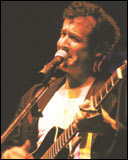
Zulu elder: Johnny Clegg is called Umgangabovu in Jo’burg hostels
Johnny Clegg still dances every Sunday in the Zulu hostels around Johannesburg, where he is now an elder and referred to as Umgangabovu, which means “the bleeding shins”. “I’m an old man, so if I stamp the ground my shins bleed,” he explains. “It’s typical Zulu, vivid, violent imagery.”
Clegg started the day in Cape Town promoting his latest album. He returned to Jo’burg for evening dance rehearsals followed by a late-night interview with me, before setting off the following morning for Durban and the Cape again.
At 53 years old, he is now a seasoned performer and his first album in four years, One Life, shows he is still a potent force in South African music. It also marks a new beginning for the white Zulu, who sings in Afrikaans for the first time with the song Thamela: Die Son Trek Water. Clegg says that this Afrikaans volkslied (folk song) is his favourite at the moment. “It is important to recognise Afrikaans as an African language.”
He even sings in French for an upbeat African tune entitled Faut Pas Baisser Les Bras, and there is a Latin-inspired number, Daughter of Eden. But fans can rest assured that Clegg is still in touch with his Zulu musical roots.
“We were not just mixing music, melody and rhythm.” Clegg reflects on his early days as the frontman of his original band, Juluka. “We were also mixing language,” he says, referring to his distinctive blend of Zulu and English, which clearly resonates on the new album. “Crossover is what I do. I have always wanted to mix language. I made world music before there was a word for it.”
Performance and dance have always been a central component of Clegg’s stage presence, and it was certainly a rare privilege to be given exclusive access to his dance rehearsal just before he left for his forthcoming European tour.
When I arrived at the studio, Clegg was busily choreographing young Zulu dancers and a group of break-dancers. Seamlessly blending old and new, urban and rural, all the vibrancy was still there.
Clegg describes how he has “always been shaped by the Zulu values”, which he has adhered to since he was a youngster. “When the chips were down in my life, it was these values that enabled me to continue.
“There were these values of inkhani, which means stubborn determination. Ukuzimisela, which means to cause yourself to stand prepared. The Zulu never go into war, or any kind of conflict, without preparation. Correct preparation is critical.” He reflects also on “the tragedy of being a man, and the tragedy of constantly needing to reinforce your status against all of the other men the area”. Most of all, his Zulu way of life has taught him about endurance and that “life is an endurance test”.
In classic Johnny Clegg style, political protest is never far away on this album. Of course, the issues have changed, and he insists that “culture should never be used as a weapon” as that “reduces its value”. But, he says, “You can make statements about the political realm that bring attention to the situation. I’ve just done this with a very hard-hitting song against Robert Mugabe [The Revolution Will Eat Its Children].” The song is also about “the inability of certain African leaders to relinquish power when it is time to do so”. There is also a song against the use of children as soldiers. “I’ve always spoken out about things.”
In relation to the future, the white Zulu’s optimism shines through. “The country is currently thundering forwards on the sheer momentum of transformation, which is just pushing us through the crime, through the unemployment. At some point it is going to have to deal with these issues.”
He refers to the dangers of xenophobia towards the many African migrants in the country, but that his “experience has been very positive”.So I ask if one day we might even get a Nigerian Zulu. “You never know,” he laughs.